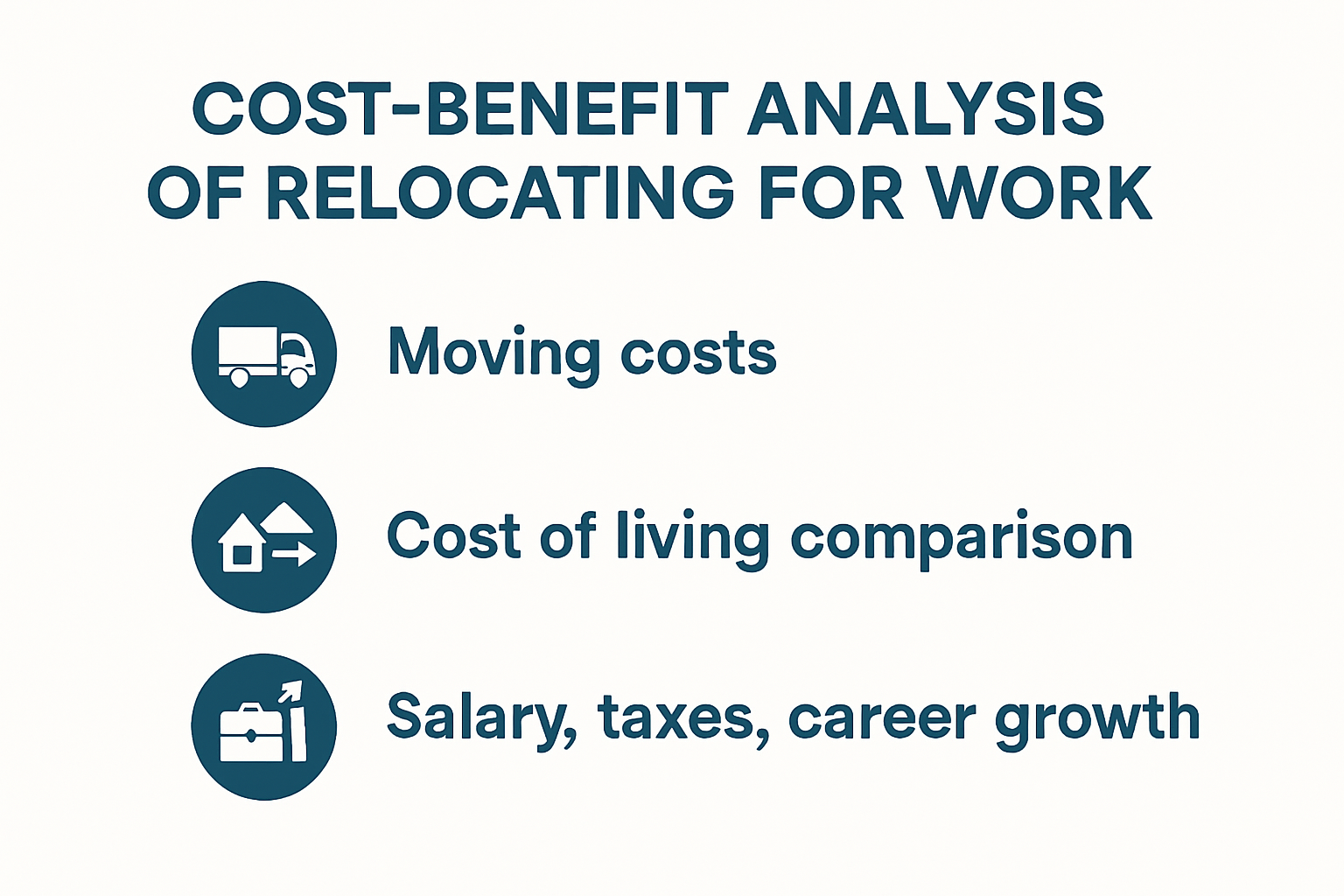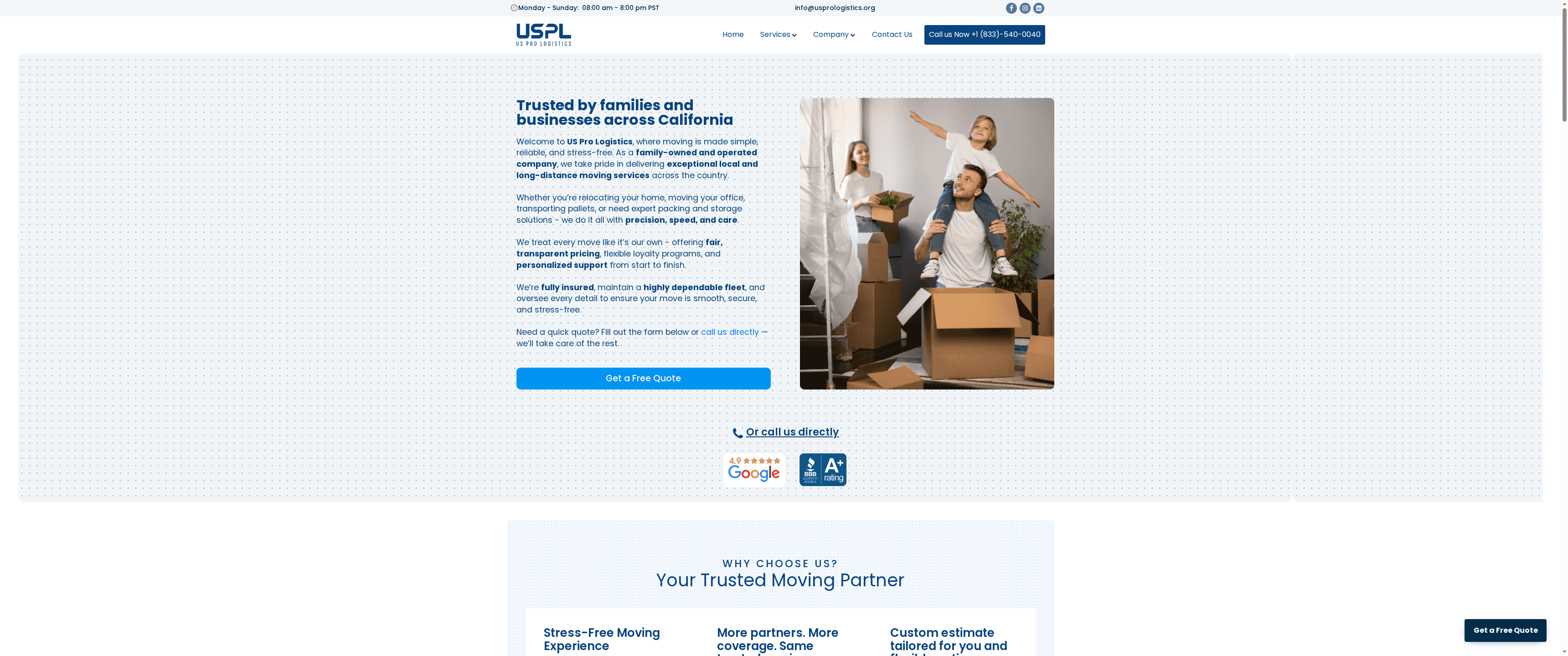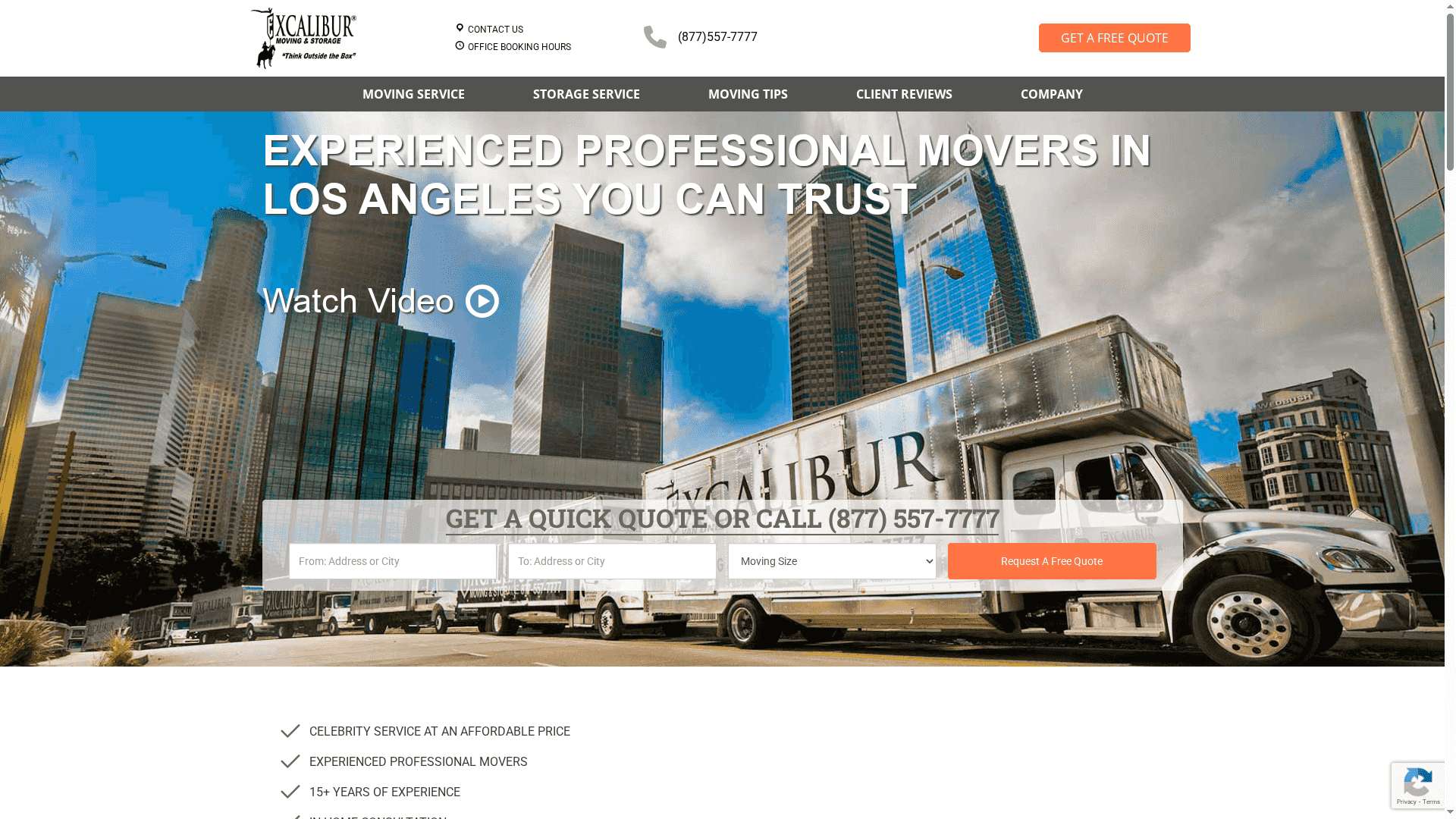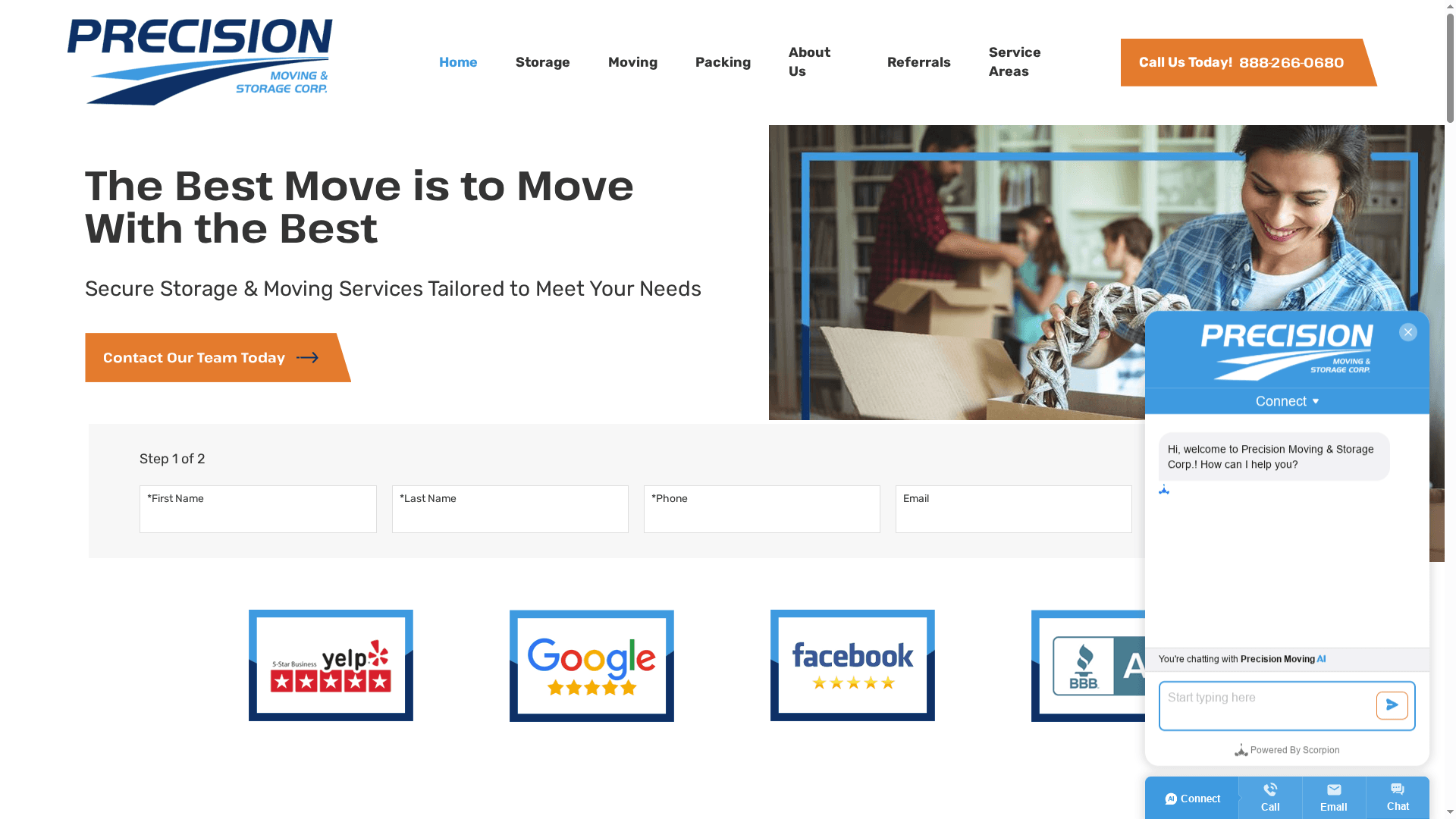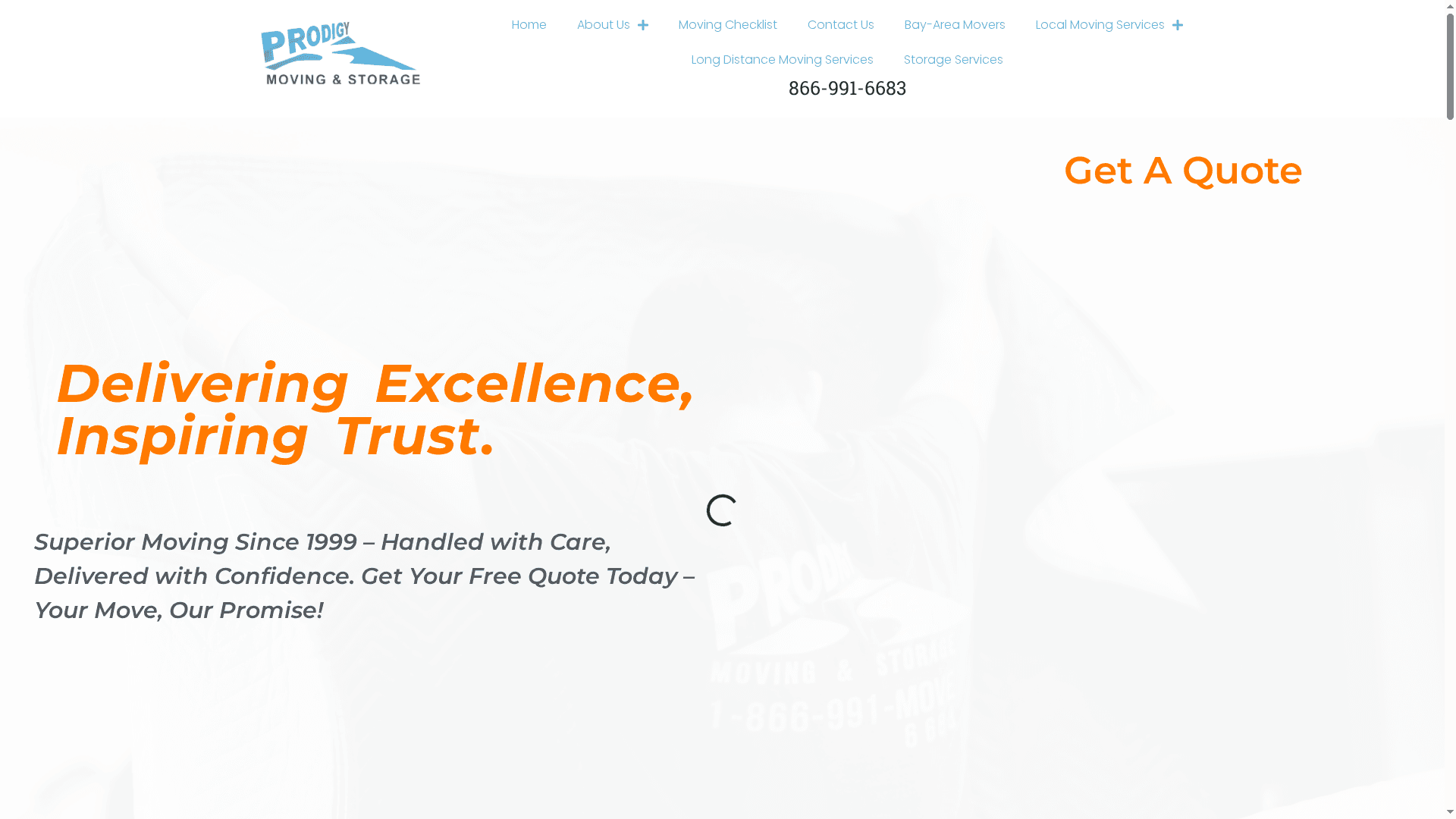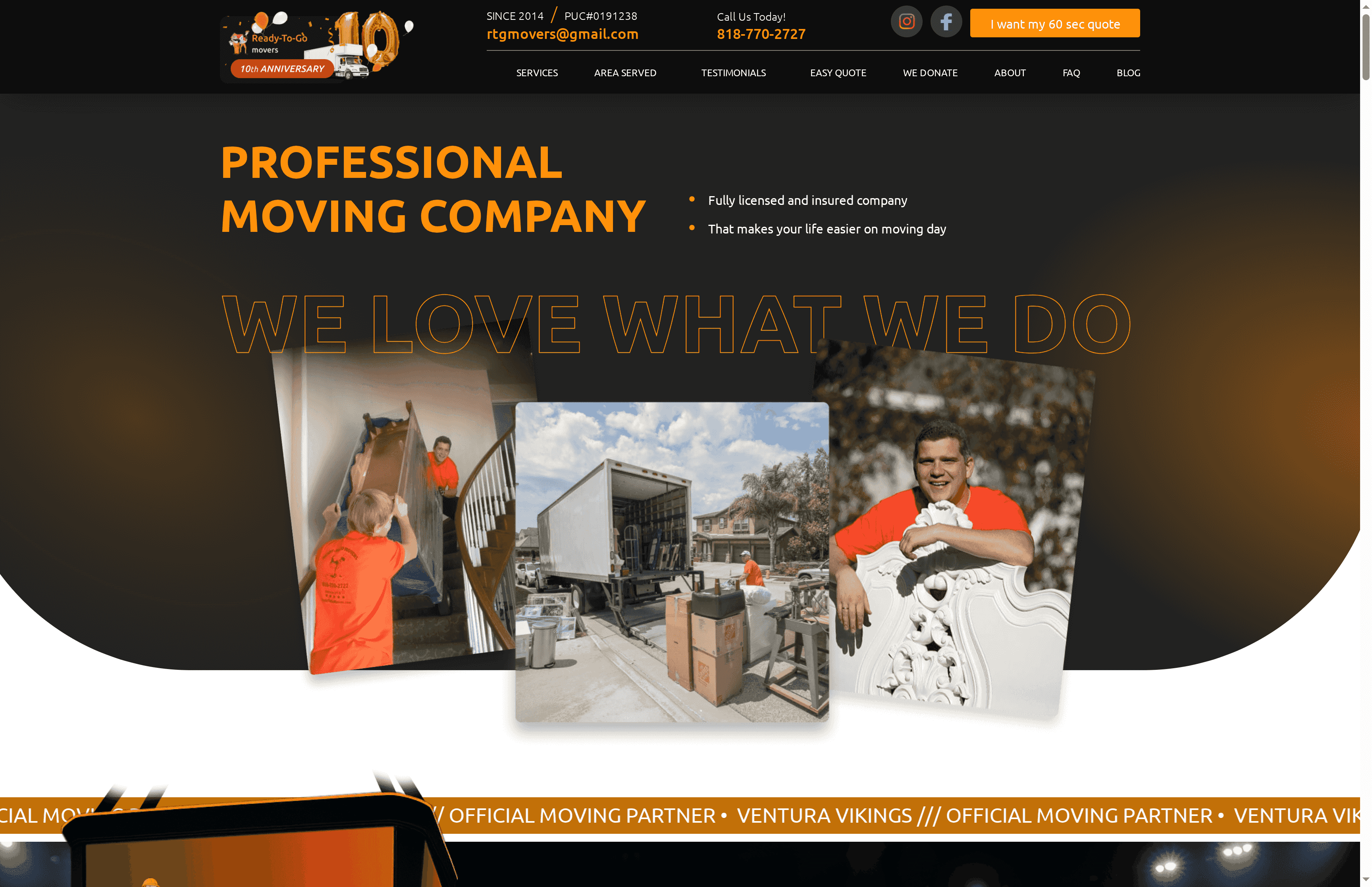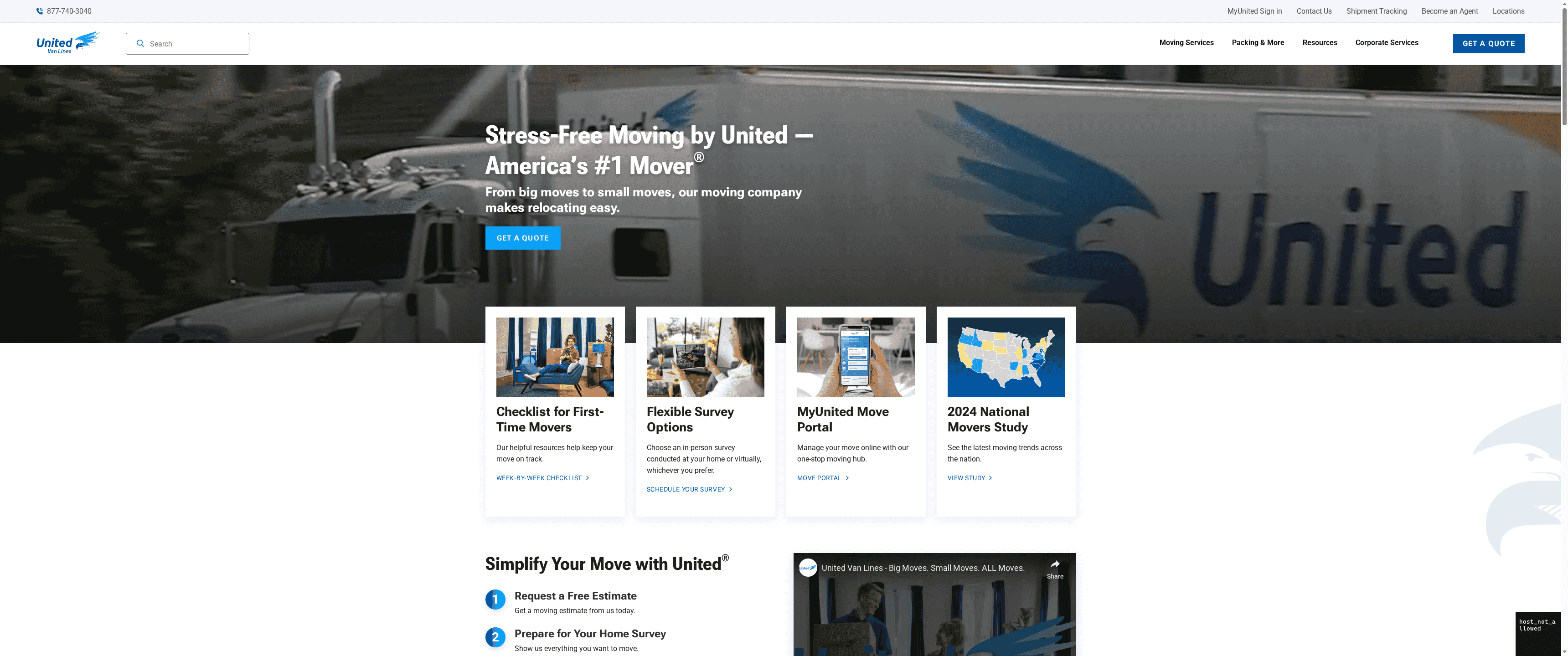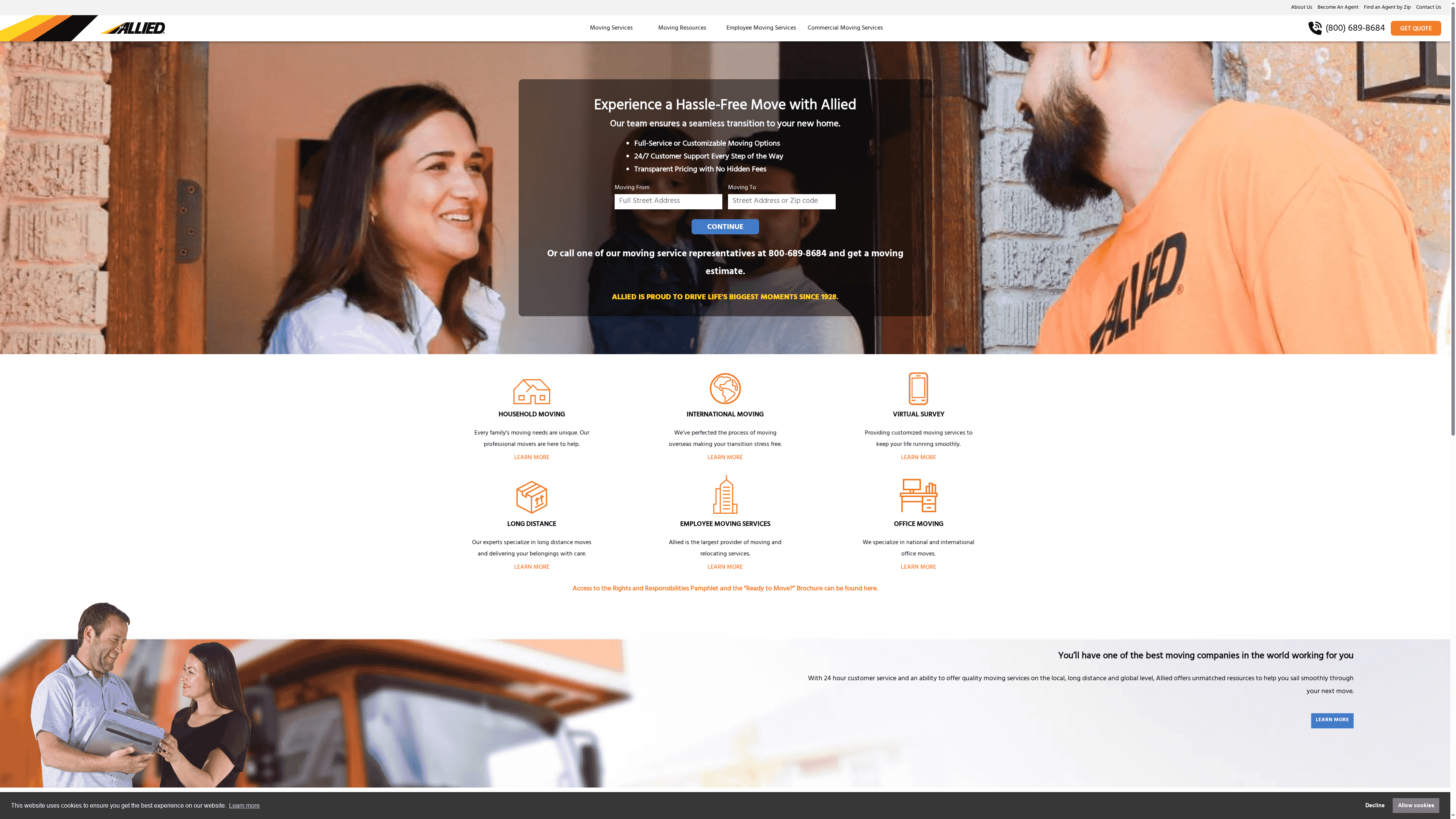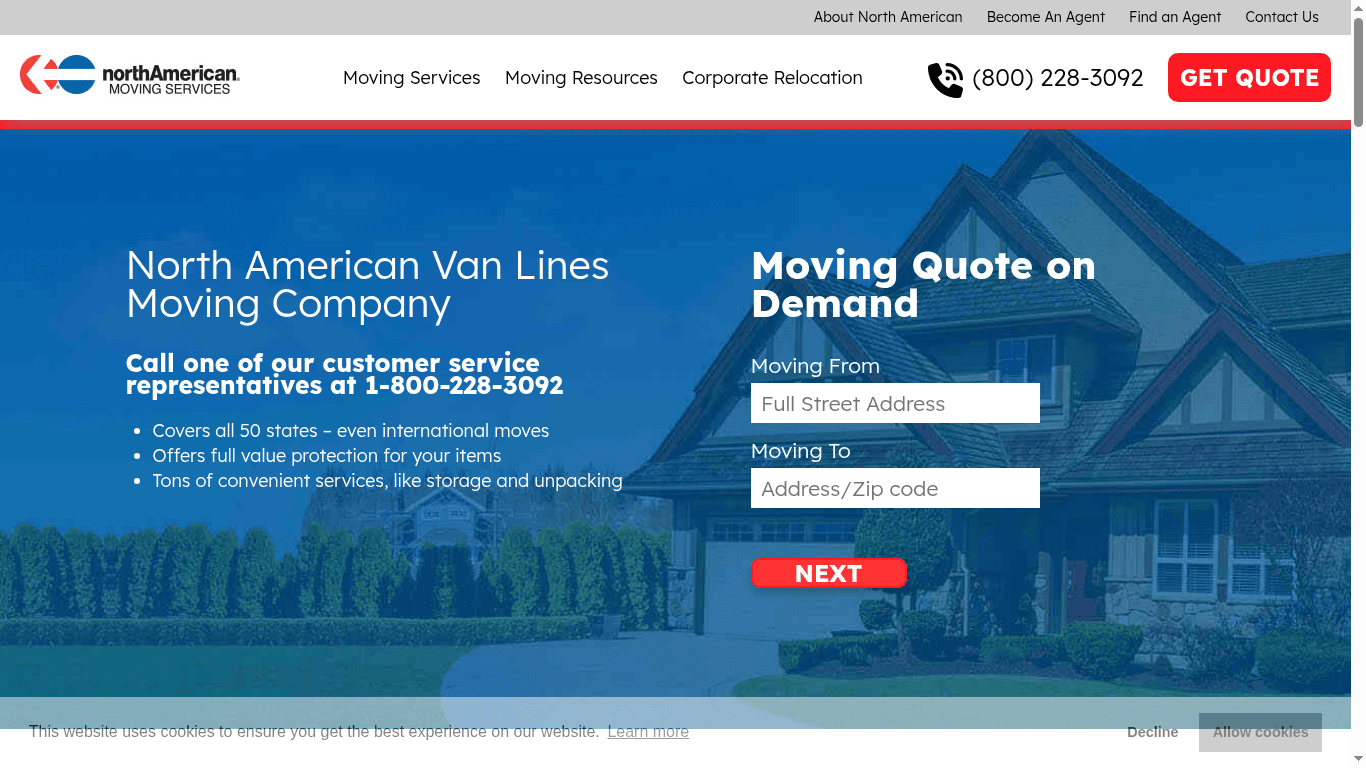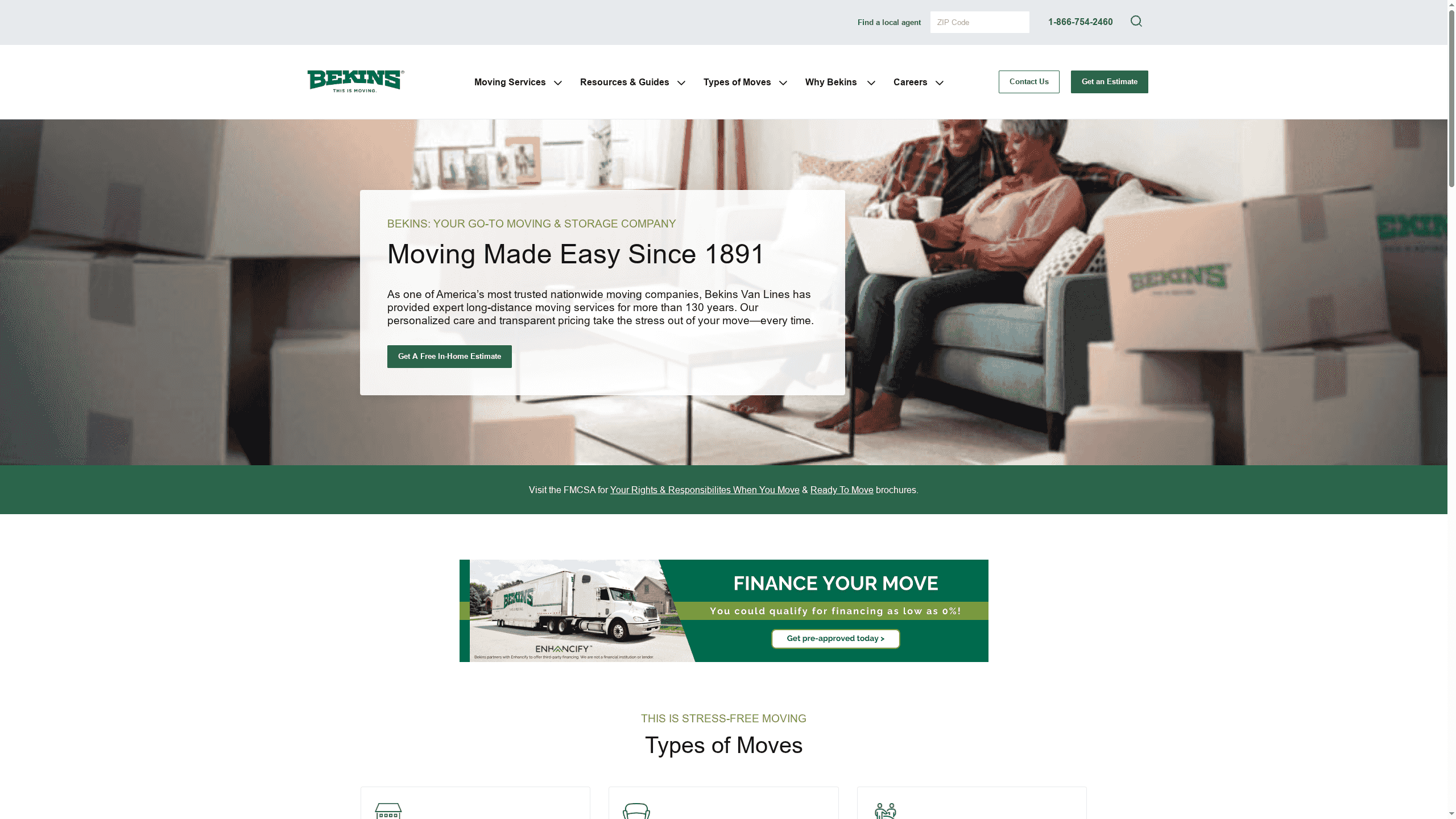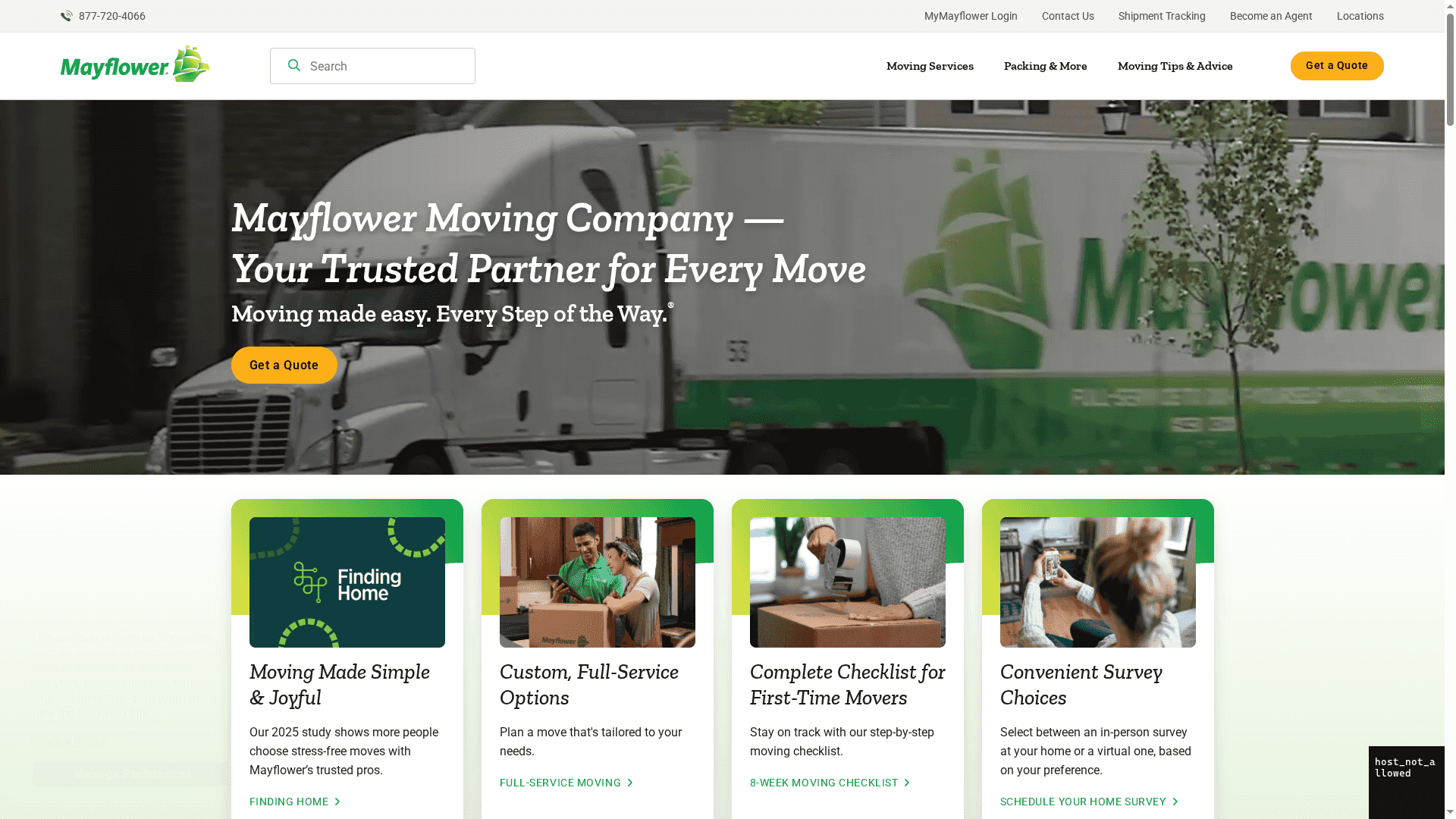Moving across town or clear across the country stirs up big questions and even bigger decisions. The details can seem endless and each choice shapes how smoothly your move unfolds. Some options put convenience first while others focus on savings or peace of mind. Different companies bring their own personalities and promises to the table and a closer look at what sets them apart can make all the difference. If you want to know what matters most when selecting a mover and which features fit your needs best you are in the right place. Prepare to discover what today’s top moving solutions really offer and what that could mean for your next big step.
Table of Contents
US Pro Logistics

At a Glance
US Pro Logistics is a family-owned moving and logistics company that focuses on reliable, personalized relocations across California and nationwide. Its service mix covers local and long-distance moves, commercial and government relocations, military and senior moves, plus freight delivery and secure storage. The site emphasizes clear communication, trust badges (USDOT and MC numbers), and direct contact via phone and email for straightforward support. Bottom line: if you need a dependable, full-service mover with military and government experience, US Pro Logistics delivers practical, no-nonsense solutions.
Core Features
US Pro Logistics combines core moving capabilities—local and long-distance moving, packing, and storage—with specialized services for commercial & office moves, government and military relocations, and senior transitions. Freight delivery handles bulky or complex items, while flexible secure storage supports short- or long-term needs. The website presents detailed service descriptions, customer testimonials, a simple quote request form, and legal disclaimers that underscore transparency and regulatory compliance. The platform is modern and mobile-optimized, with interactive menus and sliders that make it easy to find the right service and request an estimate.
Pros
- Family-owned personalization: The company’s family-owned structure supports hands-on, individualized service tailored to each household or office. This creates consistent communication and accountability throughout the move.
- Transparent and fair pricing: US Pro Logistics emphasizes upfront, transparent pricing with no hidden fees, and provides tailored estimates so you know what to expect before the truck shows up.
- Comprehensive service set: From packing and freight delivery to secure short- or long-term storage, the company covers the full moving lifecycle for residential, commercial, military, and government clients.
- Reliable, insured fleet: A dependable, insured fleet reduces risk and simplifies claims handling if anything unexpected occurs during transport.
- Community discounts: Dedicated discounts for first responders, medical professionals, and military personnel demonstrate a clear commitment to service members and emergency workers.
Who It’s For
US Pro Logistics is ideal for military families, government employees, and individuals or businesses in California and across the U.S. who need a reliable partner to handle complex logistics. It’s also a smart choice for senior moves that require extra care, companies relocating offices, and shippers needing freight or secure storage solutions. If you value personalized attention from a family-run operation and want transparent, regulated service, this company fits the bill.
Unique Value Proposition
US Pro Logistics stands out by combining family-owned responsiveness with professional infrastructure and regulatory compliance. That mix means you get attentive, personalized project management supported by an insured fleet and documented processes—critical when moving government, military, or high-value commercial accounts. The website’s clarity (detailed service pages, FAQs, trust badges, and a simple quote form) accelerates decision-making and reduces uncertainty. In short: you get small-team care without sacrificing the systems and safeguards large moves require. Competitors may offer scale or technology, but US Pro Logistics merges that infrastructure with community-focused service and targeted discounts, making it especially valuable for military and first-responder households.
Real World Use Case
Imagine a military family relocating cross-country: US Pro Logistics provides an end-to-end plan—transparent quote, packing, secure short-term storage at the destination, and scheduled delivery—all coordinated via phone or email with a dedicated contact. The result is a stress-minimized move that respects timelines and paperwork for government-related transfers.
Pricing
Quote-based — enjoy transparent pricing with no hidden fees; specific estimates are tailored for each move.
Website: https://usprologistics.org
North American Van Lines
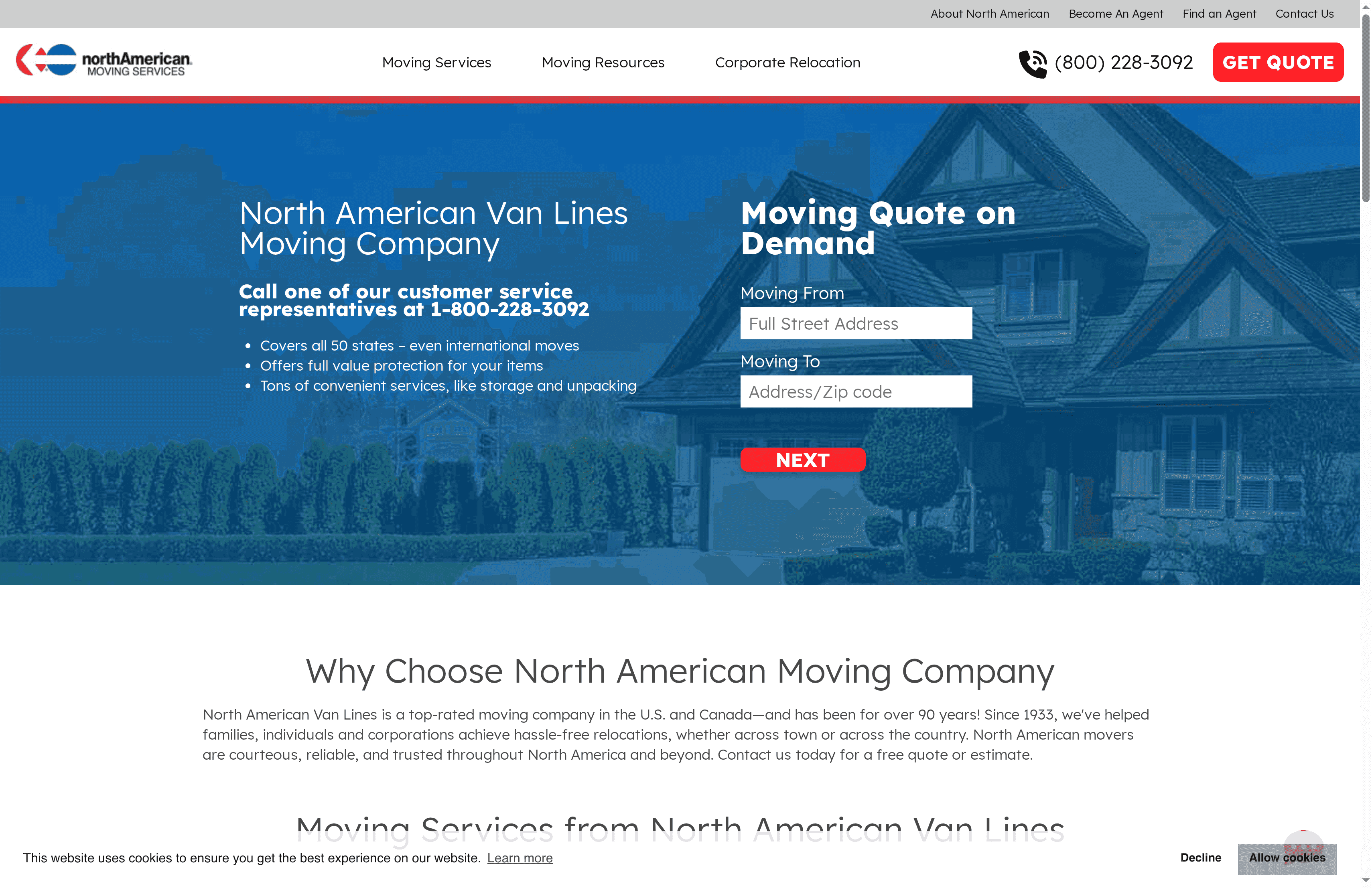
At a Glance
North American Van Lines is a veteran moving company with more than 90 years of experience, a broad agent network, and services that span local, long-distance, and international moves. Their strength is a customizable, full-service approach—packing, loading, transport, storage, and even auto shipping—with options for full value protection. That breadth makes them a solid choice when reliability and one-stop logistics matter, though exact pricing and some policy specifics require direct contact.
Core Features
North American Van Lines covers all 50 states and offers international moves through an extensive agent network of over 500 locations across the U.S. and Canada. Core capabilities include full-service packing and fragile-only packing, loading and unloading, unpacking and furniture assembly, temperature-controlled storage, corporate and office relocation expertise, auto shipping, and insurance via full value protection. Personalized moving plans aim to tailor services to different budgets and move complexities.
Pros
- Decades of experience: Founded in 1933 and operating for more than 90 years, their longevity indicates deep institutional knowledge of complex relocations.
- Extensive national and international network: With 500+ agent locations, they can coordinate moves across states and internationally while maintaining local touchpoints.
- Comprehensive service menu: From fragile-only packing to temperature-controlled storage and auto shipping, they offer services that cover nearly every relocation need.
- Personalized planning: The company emphasizes customized plans, which helps align services to specific household, corporate, or international move requirements.
- Positive reputation for reliability: The data highlights favorable customer testimonials and a strong reputation, which is important when handing over treasured belongings.
Cons
- Pricing transparency is limited: No specific pricing details are published on the website, so comparisons require requesting a quote.
- Potentially higher cost for full-service moves: Because of the comprehensive services and value protection options, full-service moves may be pricier than basic or self-service alternatives.
- Limited published policy details: The website provides limited information on guarantees for pricing stability and service timelines, so some assurances must be obtained directly from agents.
Who It’s For
North American Van Lines is best for individuals, families, and corporations that prioritize a single, trusted provider for complex or long-distance relocations—especially those moving across states or internationally who need packing, storage, and logistics coordination in one place. If you want hands-off management and established local agents at origin and destination, this company fits well.
Unique Value Proposition
Their unique value lies in combining deep industry experience with an expansive agent network and full-service options, enabling personalized relocation plans that scale from a single household to corporate office moves and international shipments.
Real World Use Case
A family relocating from New York to California can rely on North American Van Lines to provide full-service packing, secure loading, cross-country transport, and interim temperature-controlled storage, minimizing the household’s logistical burden and centralizing accountability with one provider.
Pricing
Quote-based: pricing details are not specified on the website; customers are encouraged to contact North American Van Lines for a free, customized quote.
Website: https://northamerican.com
Mayflower
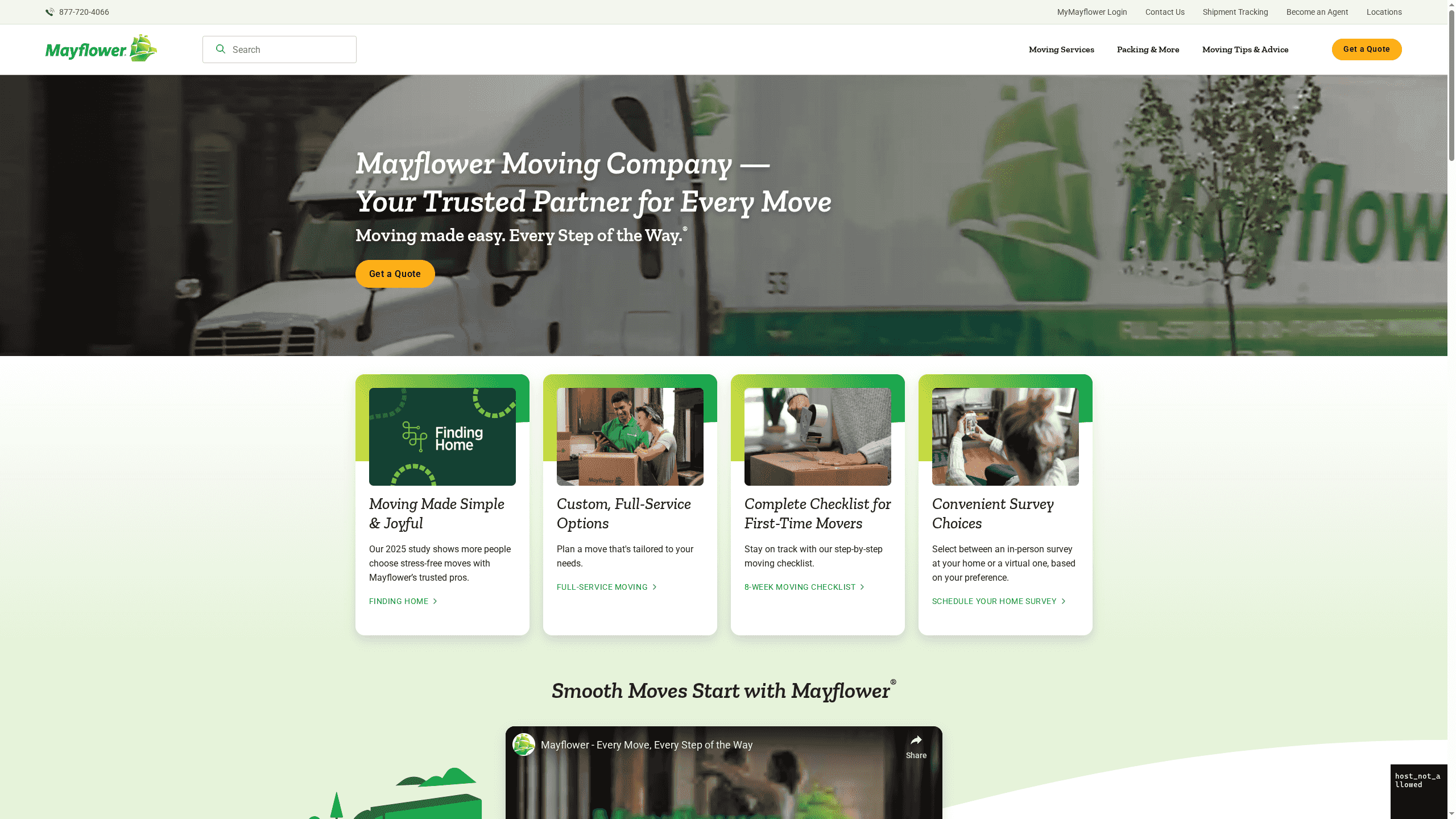
At a Glance
Mayflower is a century-spanning mover that leans on more than 90 years of experience to deliver full-service moving, storage, and vehicle shipping for local, long-distance, international, and corporate relocations. Its strength is a highly structured, customizable approach—backed by virtual and in-person surveys and an online move-management portal—to reduce stress and keep timelines transparent. If you want an established provider with professional resources and a nationwide agent network, Mayflower is a solid, reliable choice.
Core Features
Mayflower offers true full-service options: packing, unpacking, storage, and debris removal are all available as part of tailored packages. Customers can choose virtual or in-person home surveys so estimates are more accurate, and the mymayflower online portal centralizes move details, documents, and scheduling. The company also leverages a nationwide network of movers and agents to support local, interstate, and international moves, plus corporate relocations and car shipping.
Pros
- Long-standing reputation: With over 90 years in the business, Mayflower brings institutional knowledge that helps anticipate common relocation problems before they happen.
- Comprehensive and customizable services: The ability to add packing, storage, and debris removal means you can scale service levels to match your budget and stress tolerance.
- Stress-free planning tools: Virtual and in-person surveys plus the mymayflower portal give you clear milestones and a single place to manage paperwork and schedules.
- Transparent pricing practices: The company highlights transparent pricing and no deposit required, which helps reduce surprise charges during planning.
- High customer satisfaction: The data indicates positive reviews and satisfied customers, which suggests consistent service delivery across many move types.
Cons
- Potentially higher costs: Full-service offerings naturally cost more than DIY or labor-only options, making Mayflower a pricier choice for budget-focused movers.
- Limited pricing detail online: The website doesn’t publish specific pricing structures, so you must request a personalized quote to understand total costs.
- Variable service availability: Service levels and agent capabilities can differ by location, so the exact experience may vary depending on where you live.
Who It’s For
Mayflower fits individuals, families, and businesses that prioritize reliability and hands-off support over DIY savings. Choose Mayflower if you need customizable full-service moves, are planning interstate or international relocations, or require corporate move coordination with consistent agent support.
Unique Value Proposition
Mayflower pairs deep industry experience with a nationwide agent network and a centralized move-management portal. That combination lets customers convert decades of know-how into repeatable processes—virtual surveys for accuracy, bundled services for convenience, and an online hub for transparency—so complex moves are easier to plan and track.
Real World Use Case
Imagine a family planning a cross-country move: they request a virtual home survey, receive a tailored package that includes packing and short-term storage, and then track every milestone through the mymayflower portal. The result is a coordinated move with fewer surprises and centralized communications for everyone involved.
Pricing
Quote-based — pricing details are not published online; customers are encouraged to request a personalized quote to see exact costs and available service bundles.
Website: https://mayflower.com
United Van Lines
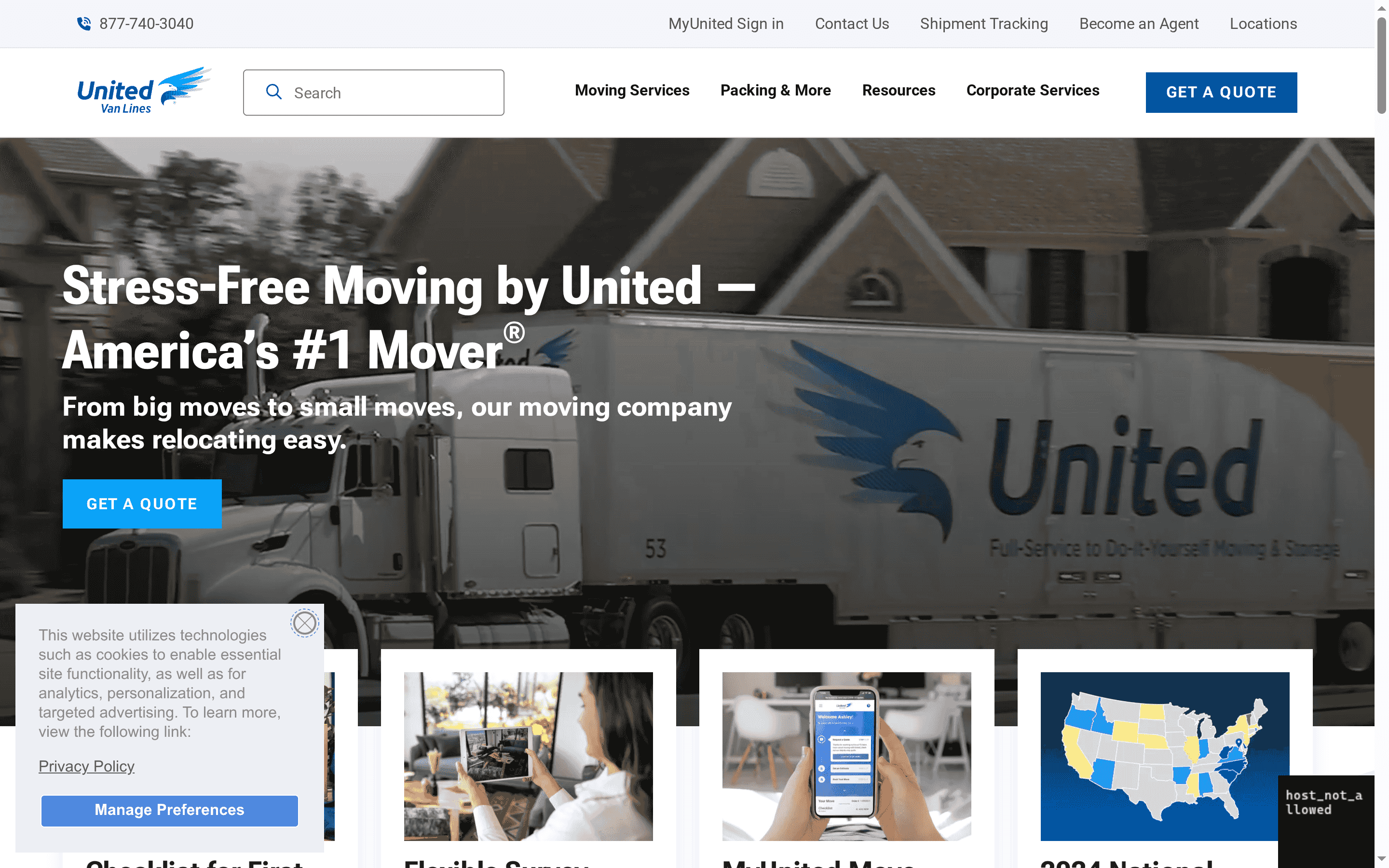
At a Glance
United Van Lines is a century-old moving company that aims to remove the guesswork from complex relocations by offering full-service, end-to-end moving solutions. If you want a single provider to handle packing, transport, vehicle shipping, storage, and claims, United presents a clear, professional option. Expect strong digital tools and a dedicated move coordinator to keep things organized, but be prepared for higher costs compared with DIY or container-style moves.
Core Features
United Van Lines packages long-distance, local, international, and corporate moves with services that include car shipping, packed and unpacked moves, and both short- and long-term storage. The company supports virtual home surveys, online move management through the myunited portal, shipment tracking, and online claim submission. Each move is assigned a dedicated coordinator and can include full-value protection for belongings—features designed to streamline logistics and reduce stress for busy households and organizations.
Pros
- Deep industry experience: With over 100 years in the industry, United Van Lines brings institutional know-how that often translates into smoother planning and fewer surprises on moving day.
- Comprehensive, full-service options: The company offers a broad lineup—from packing and unpacking to vehicle transport and in-transit storage—so you can consolidate services under a single vendor.
- Nationwide agent network: A broad network of professional movers helps support interstate and long-distance moves with licensed operations for cross-country relocations.
- Digital management tools: Online tracking, virtual surveys, and the myunited portal let you monitor the move and handle paperwork without endless phone calls.
- Customer-focused approach: The company emphasizes personalized moving plans and dedicated coordinators, which can improve communication and accountability during complex moves.
Cons
- Higher price point: United Van Lines’ full-service model typically costs more than DIY, self-service, or container options, which may not suit budget-conscious customers.
- Variable local service quality: Because operations rely on local agents, service levels can vary regionally and may affect the on-the-ground experience.
- Not ideal for minimal-service moves: If you only need a truck or a labor-only crew, United’s full-service focus may introduce unnecessary expense compared with more budget-oriented providers.
Who It’s For
United Van Lines is best for individuals, families, and organizations planning interstate or international relocations who prioritize convenience, accountability, and a single point of contact. Choose United when you want professional packing, vehicle shipping, storage options, and digital oversight—especially when time, complexity, or valuable household goods make a hands-off approach worth the premium.
Unique Value Proposition
United Van Lines combines a century of experience with an expansive network and digital move-management tools to deliver an integrated, full-service relocation experience. The value lies in consolidation: one coordinator, one provider, and a suite of services that reduce logistical friction across long-distance and international moves.
Real World Use Case
Imagine a family moving from California to Texas: United handles a virtual survey, packs household goods, ships the family car, places furniture in short-term storage, and provides online tracking through every stage—while a dedicated coordinator manages timelines and paperwork.
Pricing
Quote-based: pricing is provided via custom quotes with transparent costs and options for tailored moving plans without requiring a deposit.
Website: https://unitedvanlines.com
Allied Van Lines
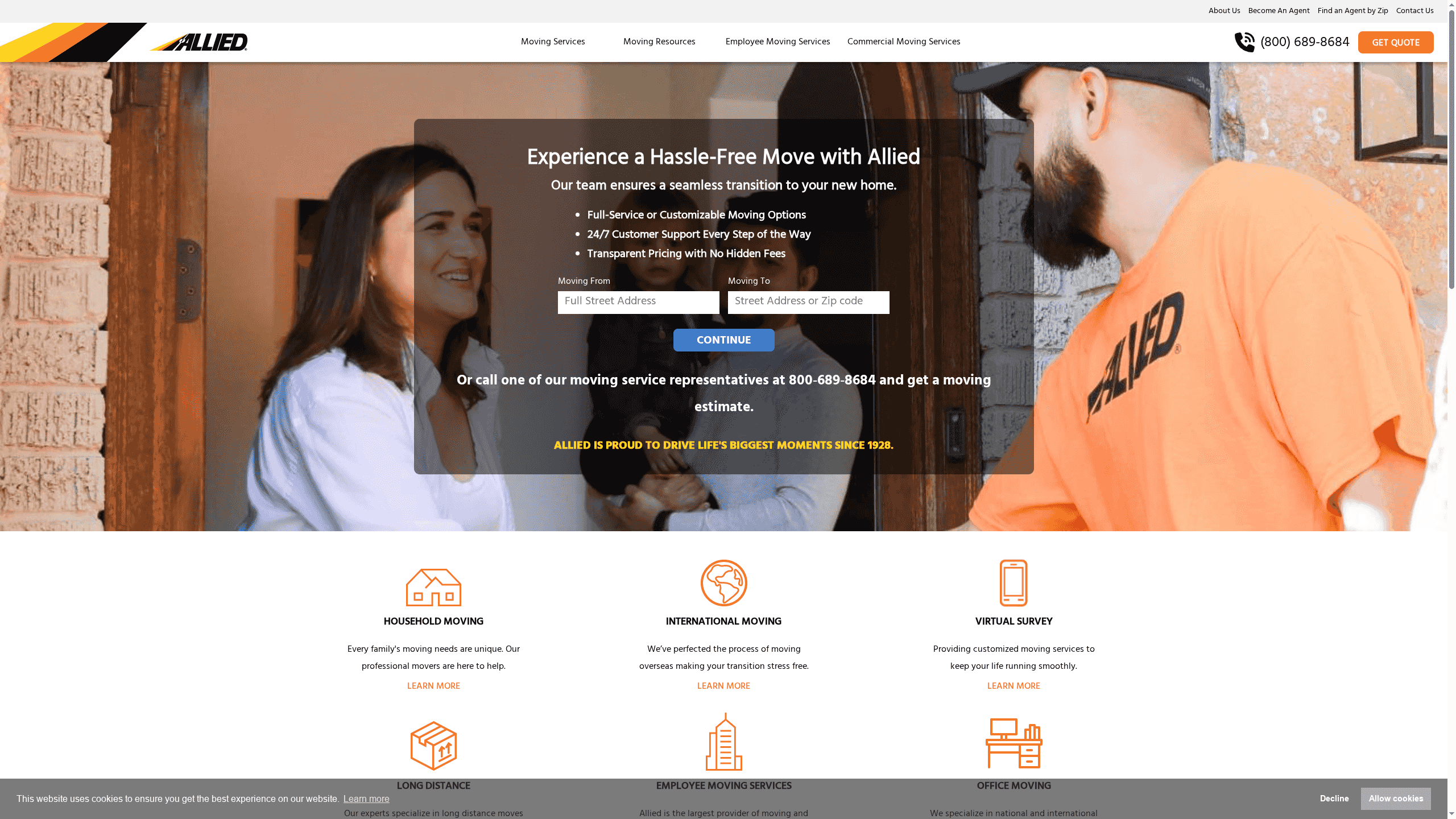
At a Glance
Allied Van Lines is a legacy full-service mover with roots back to 1928, offering end-to-end relocation support for local, long-distance, and international moves. They combine a large global network with customizable services, 24/7 customer support, and a clear emphasis on customer satisfaction. Bottom line: you get experienced teams and broad coverage, though exact pricing details often require follow-up. Consider Allied when reliability and a single-provider experience matter most.
Core Features
Allied provides full-service moving that includes professional packing, secure loading, transporting, and unpacking at destination, plus customizable service options to match family or corporate needs. They promote transparent pricing and no hidden fees in principle, backed by 24/7 customer support throughout the move. Their expertise spans long-distance and international relocations and includes virtual surveys and employee relocation services for businesses. In short: comprehensive logistics and multiple touchpoints to keep your move on track.
Pros
- Deep industry experience: Allied has operated since 1928, giving them institutional knowledge about complex relocations.
- Large global network: Their wide carrier and agent network increases coverage and logistics flexibility across destinations.
- Strong customer satisfaction: Reported customer satisfaction sits at 96%, indicating consistently positive outcomes for many customers.
- Robust service offerings: They provide virtual surveys and dedicated employee moving services, which help streamline office and corporate moves.
- Trusted brand with affordable positioning: Allied is positioned as an established brand offering competitive rates backed by reputation.
Cons
- Pricing specifics are not posted upfront: The site does not list fixed price points, so you can’t immediately compare dollar-for-dollar online.
- Quote process can be involved: Getting a complete estimate may require multiple steps and sharing detailed move information.
- Some services require a representative for exact estimates: For tailored or complex moves, you must contact a rep to get a firm price.
Who It’s For
Allied is best for individuals, families, and organizations planning local, long-distance, or international relocations who want a full-service option backed by a long history. If you value a single-provider solution with virtual surveys, employee relocation support, and round-the-clock customer service, Allied fits well. If you need instant, fixed-price clarity without follow-up, be prepared to ask questions.
Unique Value Proposition
Allied’s unique value is the combination of nearly a century of experience, extensive agent coverage, and a full-service portfolio that spans household and corporate moves. That mix reduces coordination hassle: one provider coordinates packing, transit, and destination services across regions. Reliable. Familiar. Scalable.
Real World Use Case
Imagine a family moving coast-to-coast: Allied conducts a virtual survey, schedules packing and loading, manages transport across state lines, and completes on-site unpacking—streamlining a stressful transition. Their network and experienced crews smooth the logistical rough spots so the family can focus on settling in.
Pricing
Quote-based: Pricing varies based on move specifics, with options for instant quotes and personalized estimates after consultation.
Website: https://allied.com
Atlas Van Lines
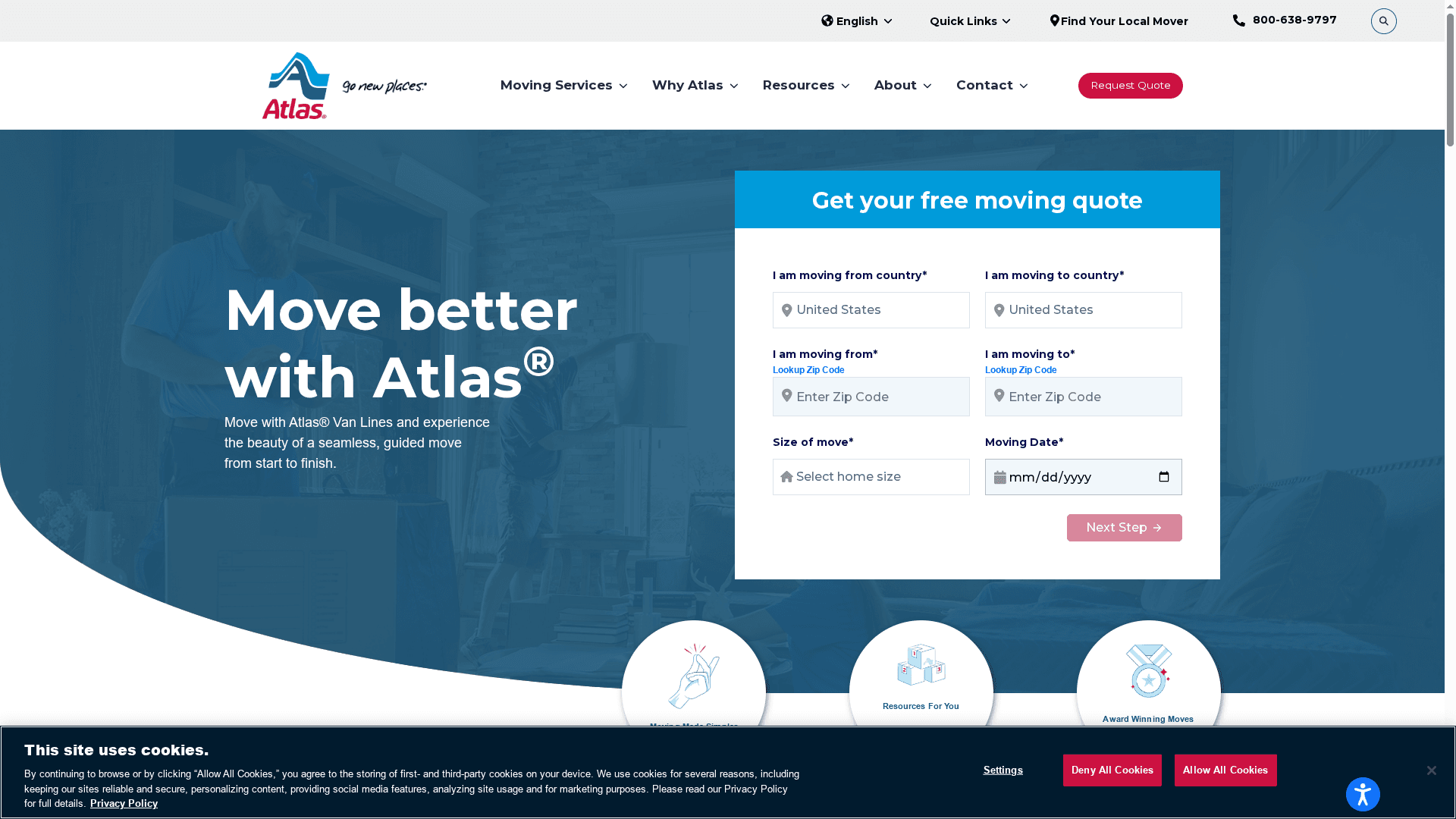
At a Glance
Atlas Van Lines is a certified moving network built to guide customers through local, long-distance, and international relocations with clear support and resources. With an extensive network and specialized services for military and government moves, Atlas emphasizes a guided, professional experience. The trade-off: pricing transparency and local agent consistency can vary, so expect to request a personalized quote and ask targeted questions up front.
Core Features
Atlas provides certified moving services supported by an extensive network of over 350 Atlas movers, covering residential, commercial, military, government, and international moves. The company offers free moving quotes and maintains resources with moving tips and expert advice to help you prepare. In practice, Atlas functions as a coordinated network that connects customers to local Atlas agents and teams, combining centralized support with on-the-ground execution.
Pros
- Extensive network providing wide coverage and expertise: Atlas’ network of more than 350 movers increases availability and options across regions.
- Offers a variety of moving services tailored to different needs: Services span local moves, long-distance relocations, international shipments, military transfers, and government moves.
- Professional and experienced team members: The emphasis on certified moving services signals formal standards and trained personnel.
- Resources and support for stress-free moving experience: Free quotes and expert-moving tips help you plan and avoid common pitfalls.
- Reliable and efficient service: The network model is built to coordinate logistics and deliver belongings with an emphasis on efficiency.
Cons
- Details about pricing are not specified on the website, which requires customers to request a personalized quote.
- Potential variability in quality depending on the local Atlas agent involved can lead to inconsistent experiences between regions.
- Not a direct moving service, but rather a network of independent movers, meaning Atlas coordinates rather than performs every service in-house.
Who It’s For
Atlas Van Lines fits individuals, families, businesses, and government or military customers who need a guided relocation with regional reach and specialized service options. Choose Atlas if you value a certified network and resources for planning, and if you’re relocating across states or internationally and want a named provider to coordinate complex logistics.
Unique Value Proposition
Atlas’ core value is its combination of certification, scale, and advisory resources: a national network of 350+ Atlas movers paired with free quotes and expert guidance to streamline complex moves. That centralized coordination, plus specialized programs for military and government relocations, positions Atlas as a full-service coordinator rather than a single local operator.
Real World Use Case
A family moving from California to Florida uses Atlas to coordinate packing, transport, and delivery. Atlas provides a free quote, connects the family with a certified local Atlas agent, and supplies moving tips and support throughout transit—reducing stress and centralizing communication during a long-distance move.
Pricing
Pricing details are not specified; customers are encouraged to get a free quote.
Website: https://atlasvanlines.com
JK Moving Services
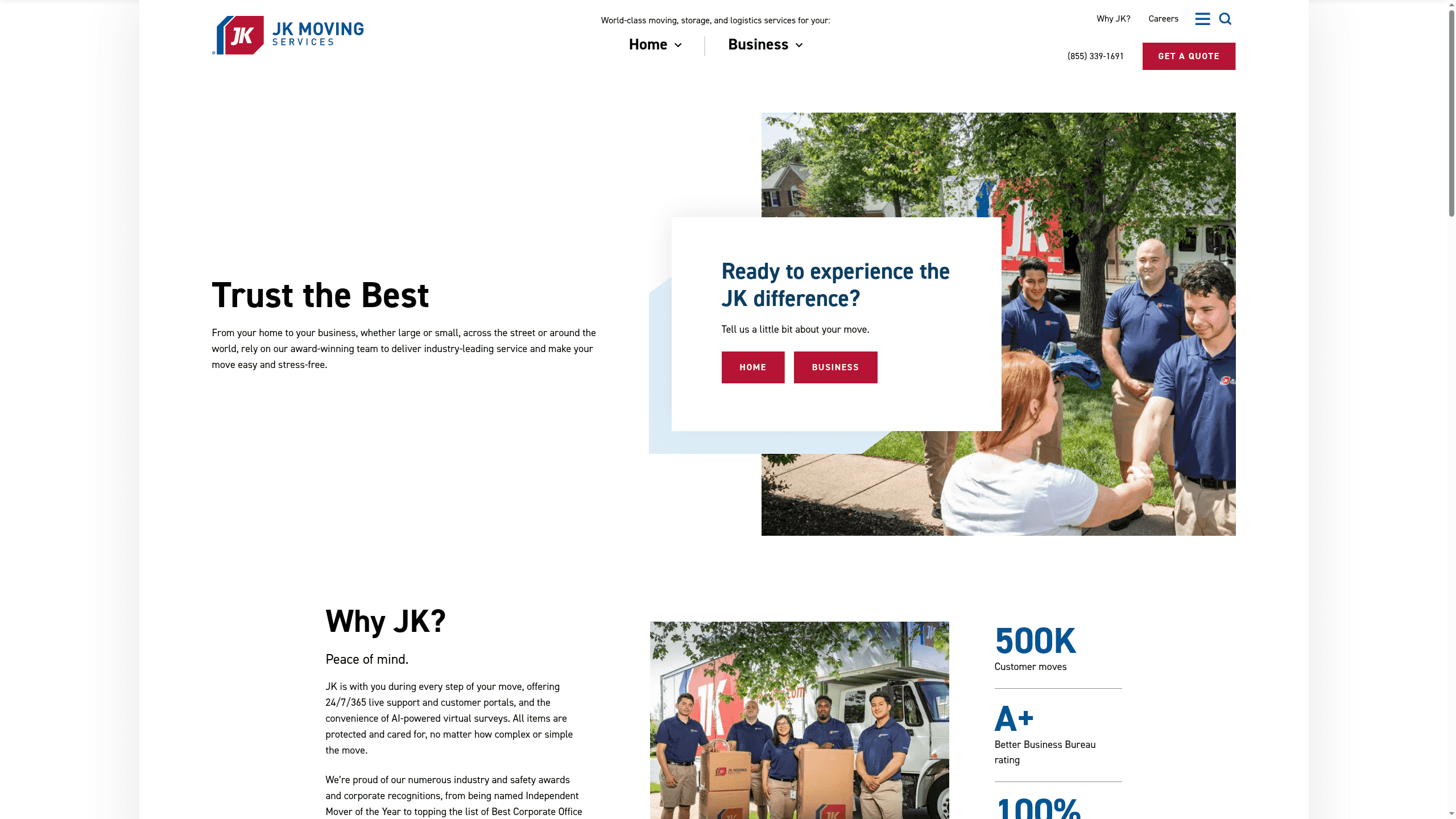
At a Glance
JK Moving Services positions itself as a full-service moving and logistics provider with strong industry recognition and a customer-focused approach. They combine traditional moving capabilities with modern touches like AI-powered virtual surveys and customer portals to reduce friction. If you want an experienced, award-winning team and 24/7 support, JK looks reliable; if you need transparent online pricing or highly detailed package tiers, expect to contact them for a custom quote. Overall: excellent for comprehensive moves, less convenient for shoppers who want instant pricing.
Core Features
JK Moving Services offers local, long-distance, and international move support alongside storage options and relocation resources. The company emphasizes technology-driven convenience via AI-powered virtual surveys that speed up estimates, plus customer portals that centralize documents and 24/7 support to keep communication open throughout the move. They also provide moving checklists and logistics resources to guide residential and commercial clients from planning to delivery.
Pros
- Experienced and award-winning team: JK highlights industry recognition and experienced staff, which typically translates to more predictable handling and fewer surprises on moving day.
- Comprehensive moving services: They support residential, commercial, and international moves, so you can use the same provider across multiple relocation types.
- High customer satisfaction: The company emphasizes strong customer feedback and awards, suggesting reliable service quality and consistent performance.
- Advanced technology for surveys and support: AI-powered virtual surveys and customer portals speed up estimates and centralize communication, reducing time spent on back-and-forth.
- Community and safety commitments: JK promotes community and safety priorities, which is reassuring for customers who want professionals that follow established protocols.
Cons
- Cumbersome website forms: The site relies on extensive form filling, which may frustrate users who prefer a quick quote or minimal data entry.
- No public pricing details: Specific pricing is not provided on the website, so you must contact JK for a tailored quote rather than getting instant rates online.
- Limited package detail without consultation: Service package specifics are not fully listed, requiring consultation to understand exactly what is included and any potential add-ons.
Who It’s For
JK Moving Services is ideal for individuals, families, and businesses that need reliable, full-service moving and storage solutions and are comfortable engaging directly with a provider to customize their move. If you value experienced crews, technology-enabled estimates, and around-the-clock support, JK is a strong fit. If you need immediate, transparent online pricing before speaking to someone, this may be less convenient.
Unique Value Proposition
JK blends traditional moving expertise with modern logistics tools: award-winning crews backed by AI surveys and customer portals. That combination reduces manual guesswork and helps ensure a smoother, documented move from planning to storage or international shipment.
Real World Use Case
A small business relocating offices could use JK for end-to-end logistics: virtual surveys to scope the project, coordinated packing and transport, short-term storage if needed, and a customer portal to track timelines—minimizing downtime and protecting assets during transition.
Pricing
Quote-based — pricing is not specified on the website and requires direct contact for a customized estimate.
Website: https://jkmoving.com
U-Pack
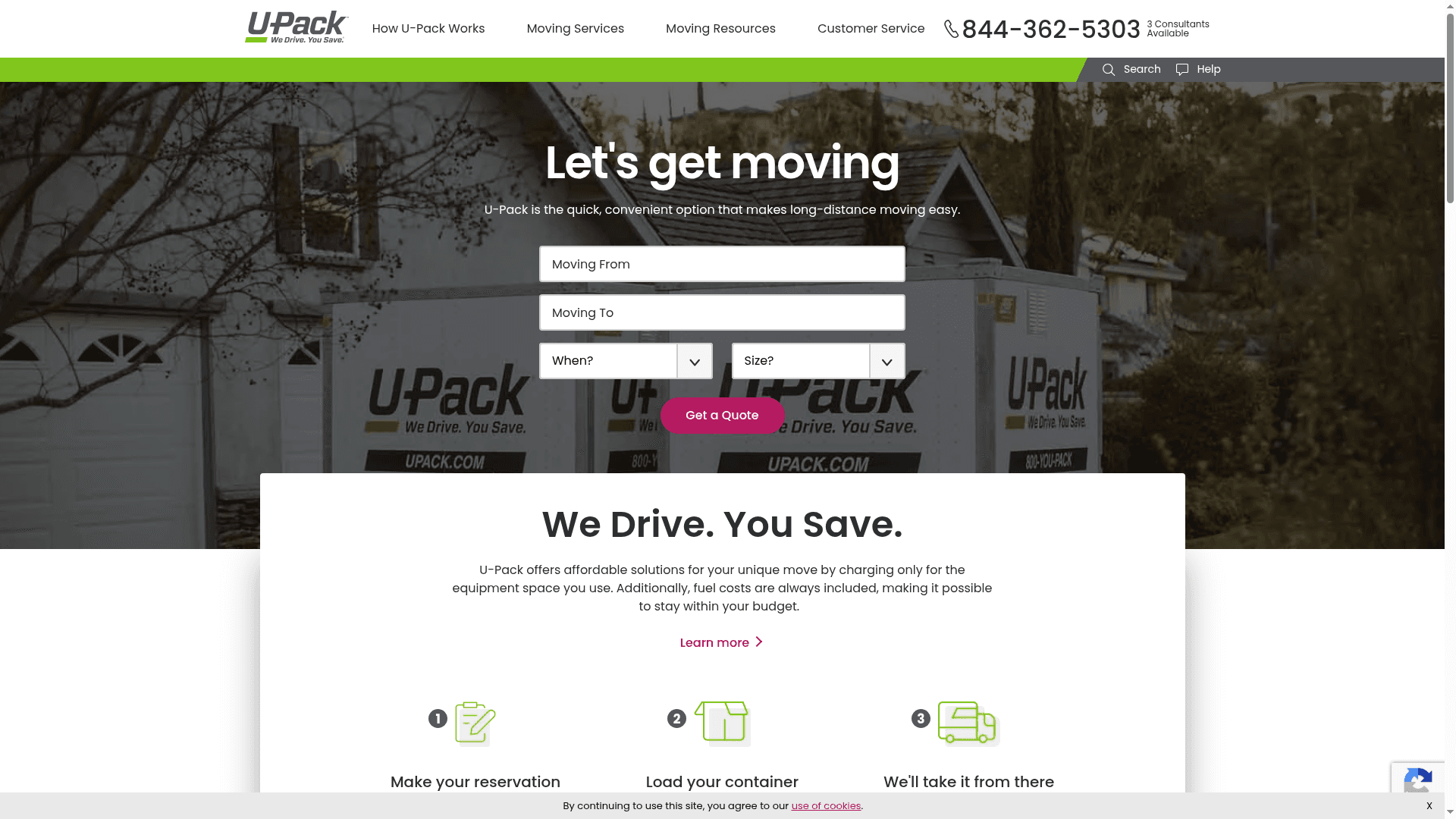
At a Glance
U-Pack is a long-distance household mover that emphasizes cost transparency and online convenience. You pay for the amount of equipment space you use, and fuel costs are included in the quoted rate, which helps with budgeting. The company pairs flexible service options—like door-to-door delivery and storage—with online move management and a dedicated support team to guide you. Bottom line: U-Pack is a budget-conscious choice for families who prioritize control and transparency during a cross-country move.
Core Features
U-Pack’s core strengths center on flexible, space-based pricing and a heavily digital workflow. Key capabilities include door-to-door delivery, optional storage, and guaranteed transit choices; the ability to pay only for the equipment space you occupy; online move management tools and planning resources (checklists and how-to guides); and a dedicated customer support team to assist through booking, loading, and delivery. Fuel costs are included in rates, which simplifies comparing quotes.
Pros
- Transparent pricing structure: You pay based on the equipment space you actually use, making it easier to estimate and control costs rather than guessing a flat fee.
- Fuel included in rates: Fuel costs are rolled into the quoted rate, reducing surprise charges and improving budget certainty.
- Flexible service options: Services such as door-to-door delivery, storage, and guaranteed transit let you tailor the move to your schedule and needs.
- Strong online tools and resources: Checklists, how-to guides, and online move management streamline planning and reduce the back-and-forth of a complex long-distance move.
- Dedicated customer support: A named support team is available to help guide you through the process from booking through delivery, which is valuable when timelines are tight.
Cons
- Service availability may vary: Availability of specific services and exact offerings can differ by location or move size, which could complicate planning for certain origins or destinations.
- Unclear additional cost details: The description does not detail other potential costs beyond fuel—such as packing materials, insurance options, or third-party fees—so you may need to verify extras before committing.
- Limited public ratings in the data: There’s little information in the provided description about independent customer reviews or ratings, making it harder to assess real-world performance from the data alone.
Who It’s For
U-Pack is best suited for individuals and families planning long-distance household moves who want to control costs and handle much of the loading/unloading themselves or with minimal onsite labor. If you value online management, flexible timing, and predictable fuel-inclusive pricing, U-Pack fits. It’s particularly appealing to budget-conscious movers who prefer to tailor service level and storage options to match their timeline.
Unique Value Proposition
U-Pack’s unique value lies in its space-based pricing model combined with fuel-inclusive rates and a digital-first move management experience. That combo gives you clearer upfront cost signals and the flexibility to scale the service to exactly how much space you need—no more, no less.
Real World Use Case
A family moving across the country loads only the container space they need, uses the online portal to schedule pickup and track progress, relies on included fuel costs for budget certainty, and adds storage for a few weeks while their new home is readied. The dedicated support team answers questions and helps coordinate delivery.
Pricing
Quote-based — rates are determined by the amount of equipment space used, with fuel costs included in the rate.
Website: https://upack.com
Moving Services Comparison
This table provides a comprehensive comparison of various moving services, highlighting their core features, pros, cons, and pricing models.
| Company |
Core Features |
Pros |
Cons |
Pricing |
| US Pro Logistics |
Local & long-distance moving, secure storage, military relocations |
Family-owned personalization, transparent pricing, community discounts |
Pricing only through quotes |
Quote-based, no hidden fees |
| North American Van Lines |
Full-service packing, auto shipping, international reach |
Decades of experience, personalized planning |
Limited pricing transparency |
Quote-based, customized estimates |
| Mayflower |
Full-service moving, online portal, debris removal |
Long-standing reputation, stress-free tools |
Potentially higher costs |
Quote-based, no deposit required |
| United Van Lines |
End-to-end solutions, digital move management |
Deep experience, comprehensive options |
Higher price point |
Quote-based, tailored plans |
| Allied Van Lines |
Professional packing, 24/7 support |
Strong customer satisfaction, global network |
Quote process can be involved |
Quote-based, competitive rates |
| Atlas Van Lines |
Certified moving services, free quotes |
Extensive network, tailored services |
Pricing details unspecified |
Quote-based |
| JK Moving Services |
AI-driven surveys, customer portals |
Award-winning team, advanced technology |
No online pricing details |
Quote-based, contact required |
| U-Pack |
Space-based pricing, online tools |
Transparent pricing, flexible options |
Service availability may vary |
Quote-based, fuel included |
Trusted Military Moving Services Tailored to Your Needs
Finding reliable moving services for military families can be challenging when you face strict timelines, complex logistics, and the need for trustworthy support. The article “Best Military Moving Services Expert Comparison 2025” highlights the importance of transparent pricing, personalized communication, and specialized experience for military relocations. At US Pro Logistics we understand these unique challenges and their emotional weight that is why we offer comprehensive military and government moving solutions with dedicated support designed to ease your transition. Our family-owned approach means you get personalized care clear communication and a seamless move experience each step of the way.
Explore our range of services crafted specifically to assist military families and veterans including secure storage freight delivery and transparent upfront pricing without hidden fees. When you choose US Pro Logistics you also benefit from community-focused discounts honoring your service. For more details about our specialized offerings visit our undefined category page and see how our full-service solutions set us apart.
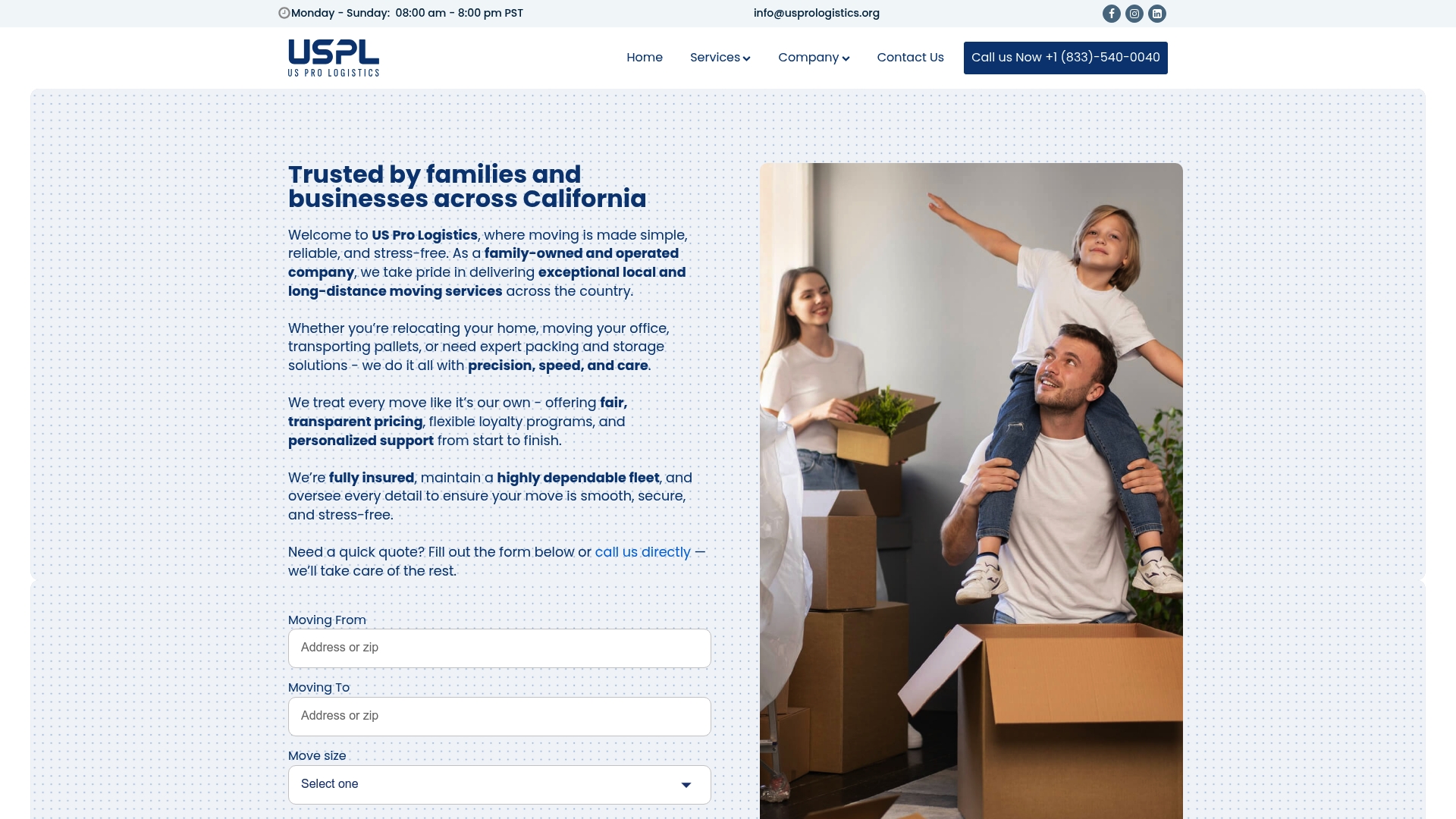
Start your hassle-free military move today with a trusted partner who puts your needs first. Contact US Pro Logistics now at https://usprologistics.org to request a personalized quote and experience moving support built on reliability and respect for your service.
Frequently Asked Questions
What should I consider when choosing military moving services?
Choosing military moving services means evaluating factors like experience with military relocations, transparent pricing, and additional support such as specialized packing for sensitive items. Prioritize companies that understand the unique needs of military families to ensure smooth transitions with minimal stress.
How can I request quotes from military moving services?
To request quotes, visit the websites of military moving services and look for a quote request form. Provide details such as your moving timeline, items to be relocated, and any special requirements to receive tailored estimates.
What types of services do military moving companies typically offer?
Military moving companies typically offer a range of services including packing, loading, transport, and storage solutions. Check for added benefits such as vehicle shipping and specific support for government documentation to ensure a comprehensive relocation experience.
How far in advance should I book military moving services?
It’s best to book military moving services at least 30–60 days in advance to ensure availability and proper planning. Early booking can also facilitate smoother communication and minimize last-minute complications.
Can military moving services assist with international relocations?
Yes, many military moving services are equipped to handle international relocations, which often include customs assistance and logistics coordination. Confirm international capabilities during your initial inquiries to align with your moving needs.
Are there special discounts available for military families using moving services?
Many moving services provide discounts specifically for military families to honor their service. Inquire about promotional offers or special rates to potentially lower your overall moving costs.
Recommended
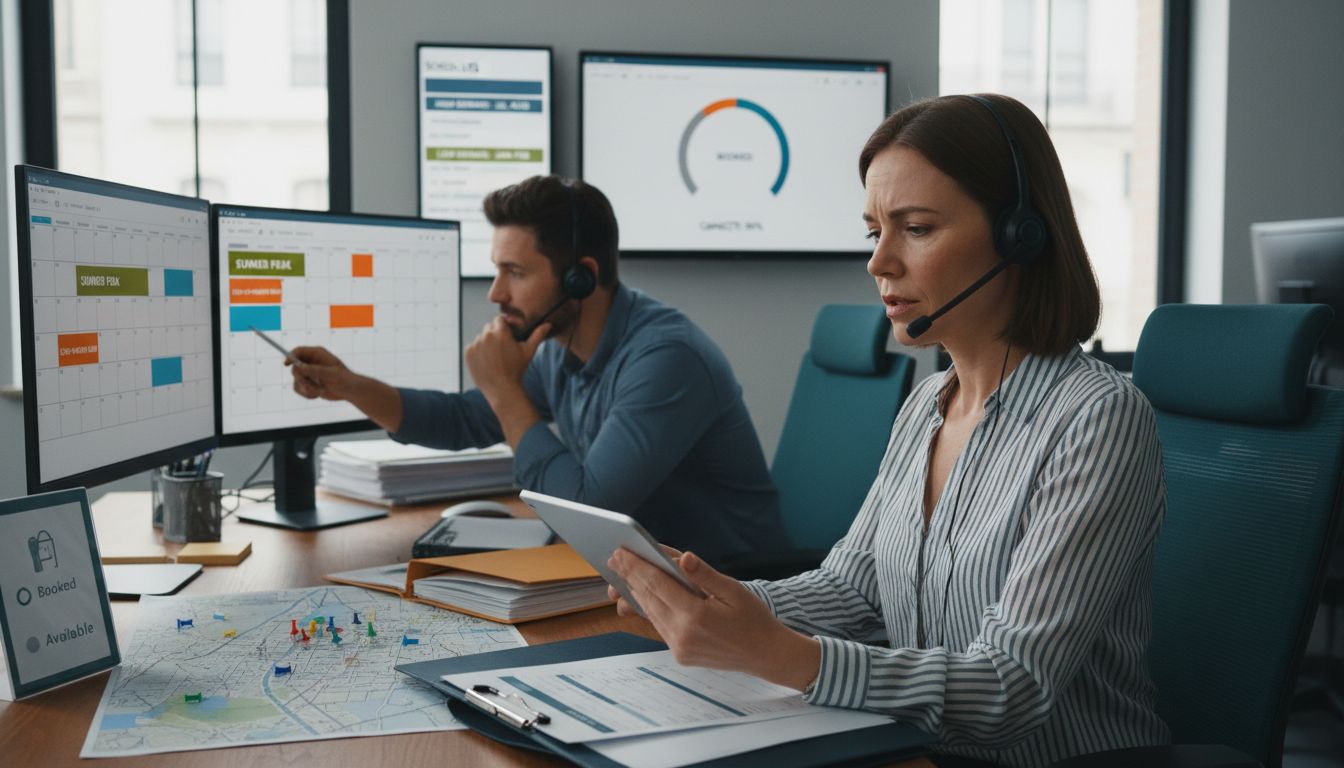
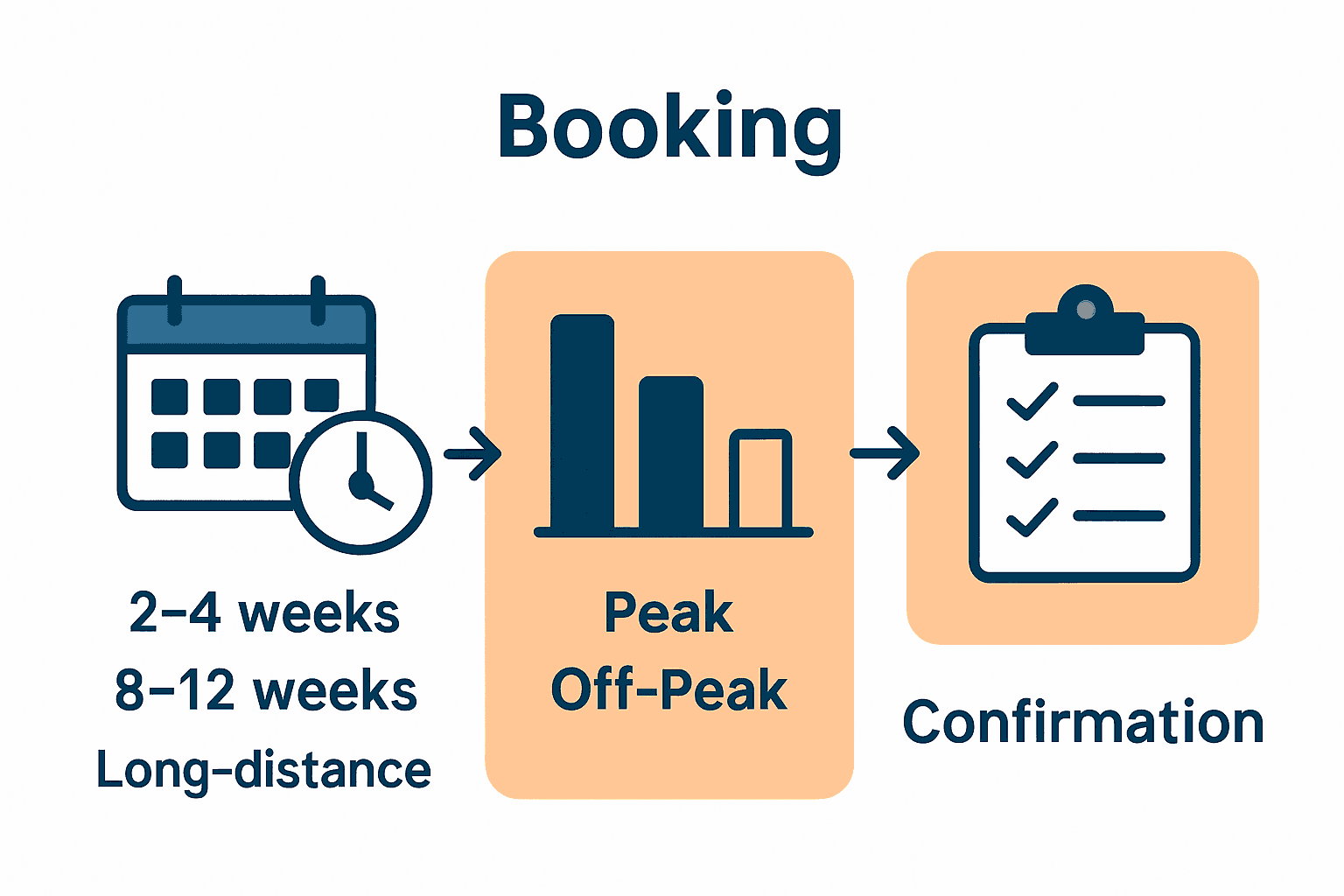

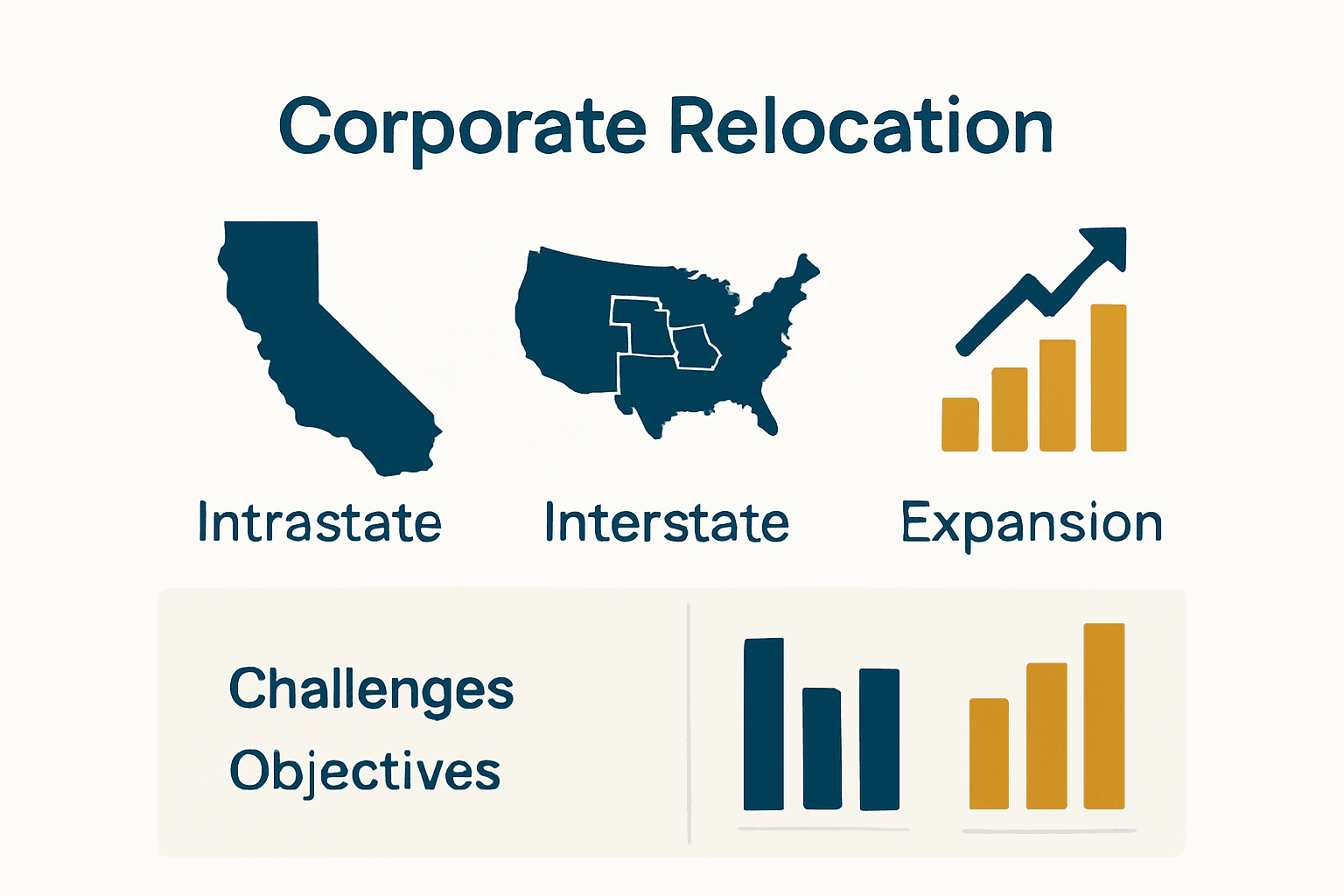 Professional moving services play a critical role in transforming these potentially disruptive transitions into smooth, strategic opportunities for organizational evolution.
Professional moving services play a critical role in transforming these potentially disruptive transitions into smooth, strategic opportunities for organizational evolution.

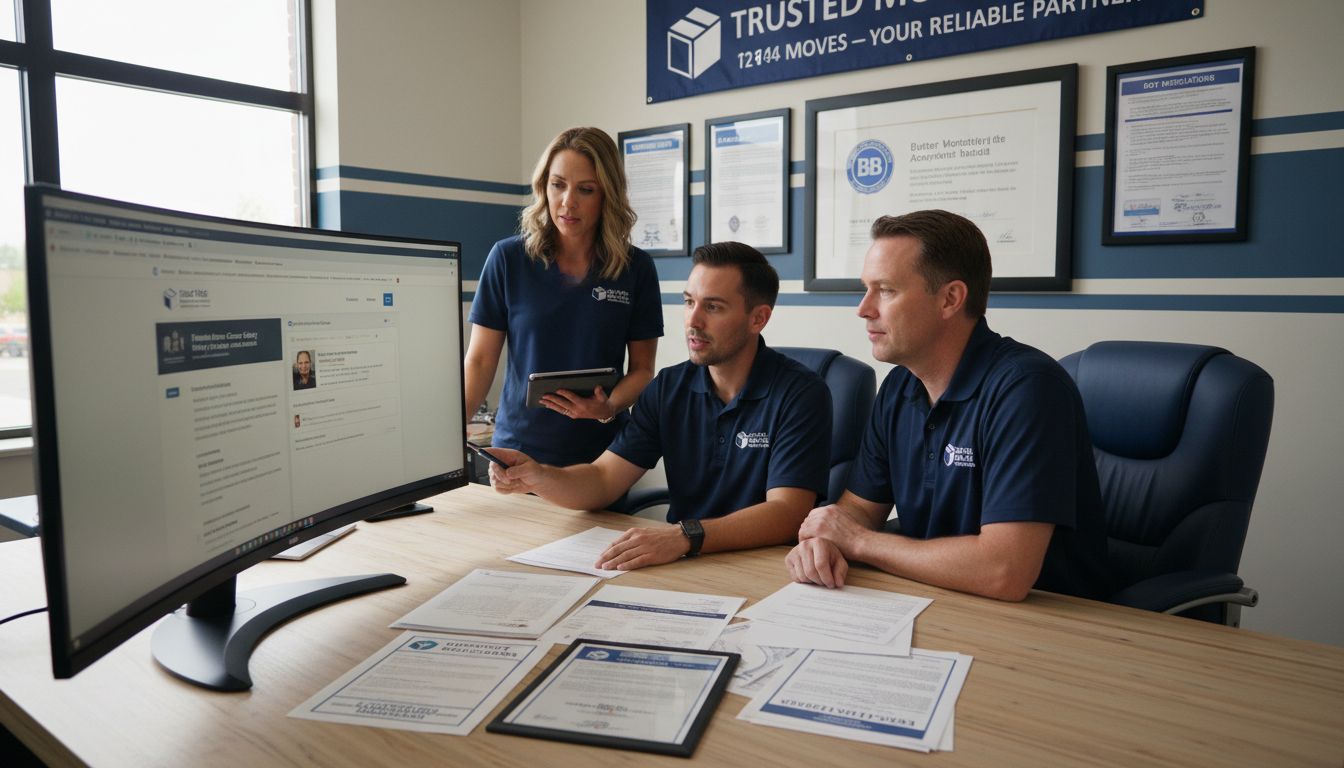 Your next step will involve requesting detailed estimates and comparing the specific insurance options offered by different moving companies.
Your next step will involve requesting detailed estimates and comparing the specific insurance options offered by different moving companies.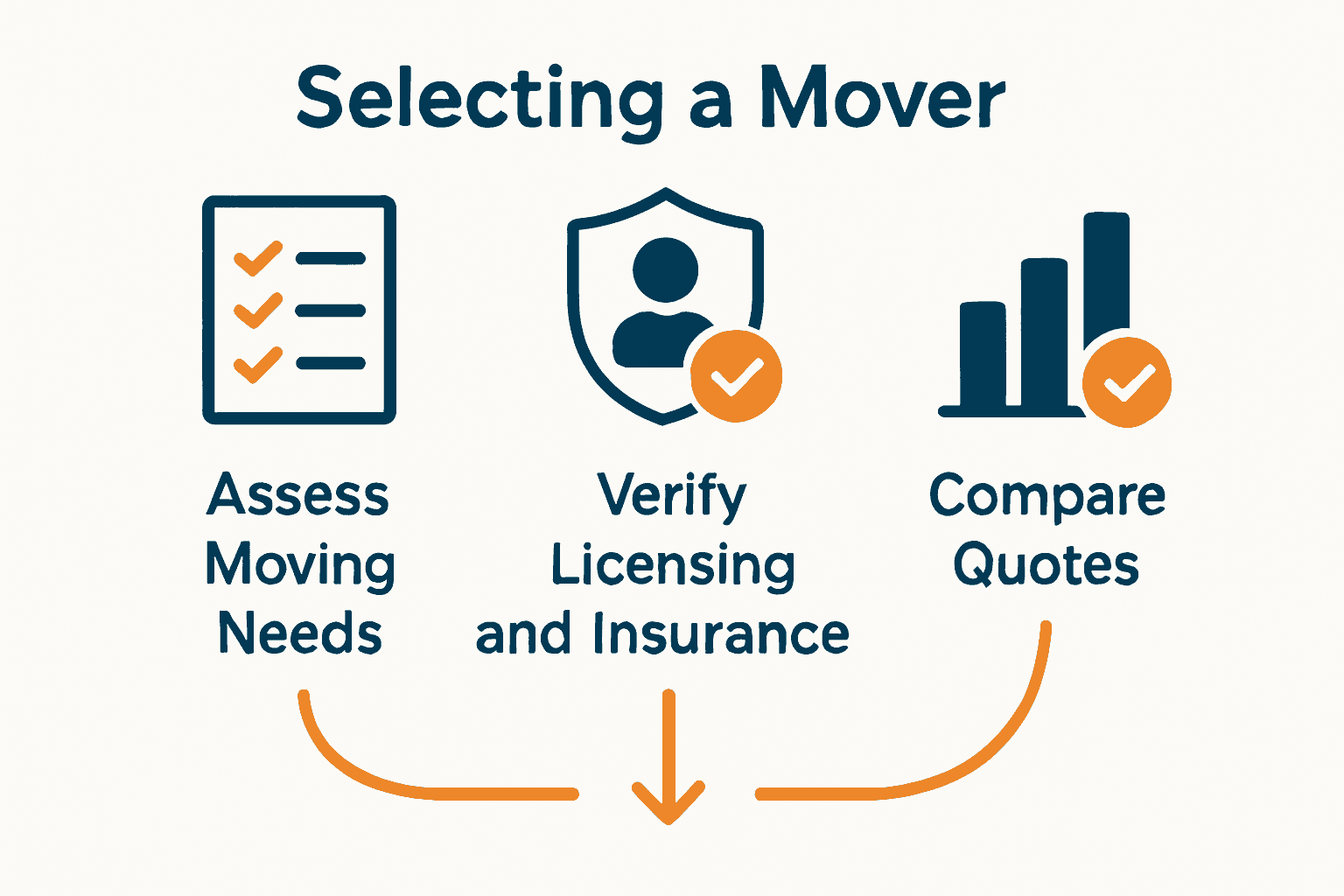 Your next step will involve carefully reviewing the terms and conditions of each estimate and preparing follow-up questions for potential movers.
Your next step will involve carefully reviewing the terms and conditions of each estimate and preparing follow-up questions for potential movers. By handling every aspect of your move with precision, they allow you to focus on the excitement of your new beginning rather than the logistics of getting there.
By handling every aspect of your move with precision, they allow you to focus on the excitement of your new beginning rather than the logistics of getting there.
